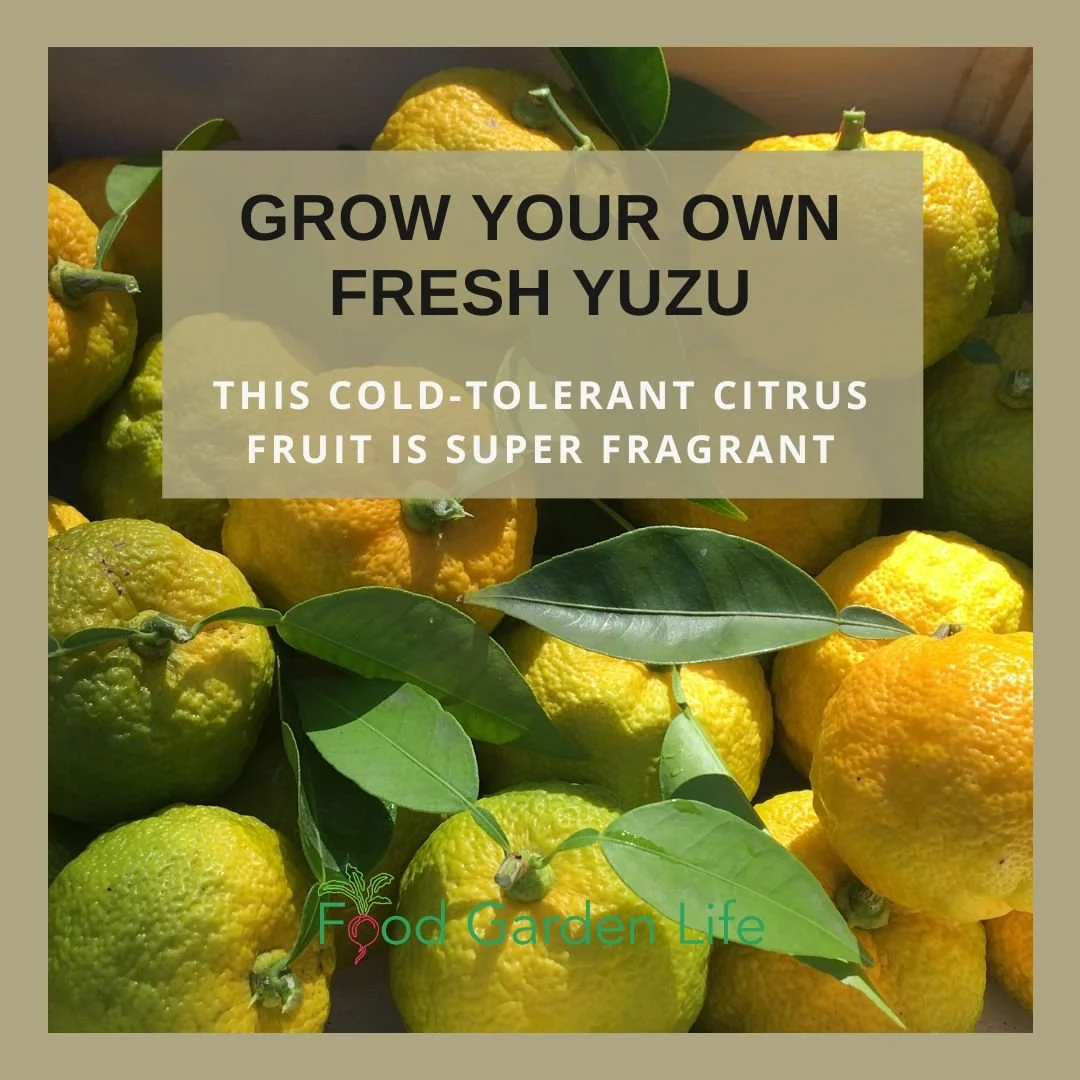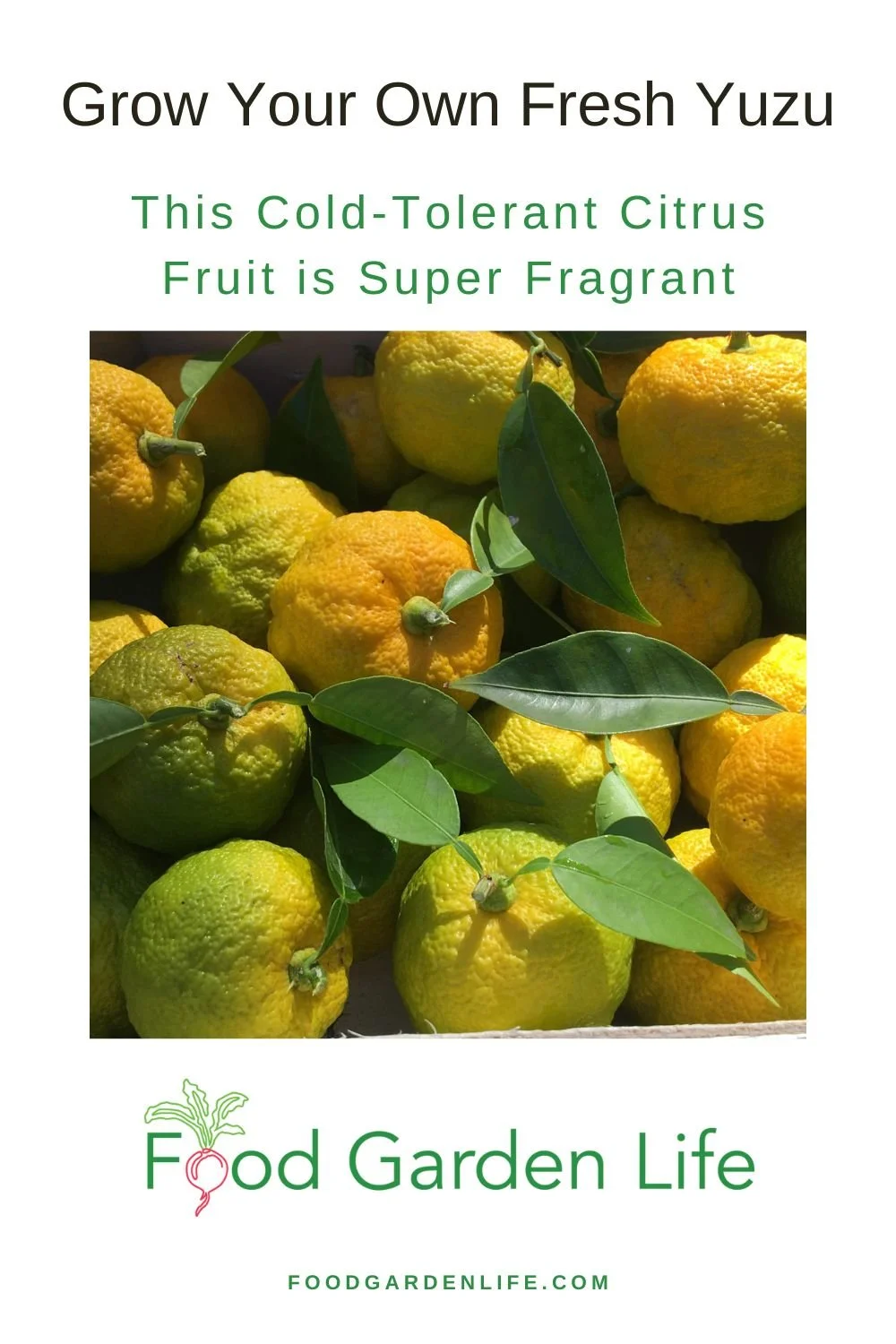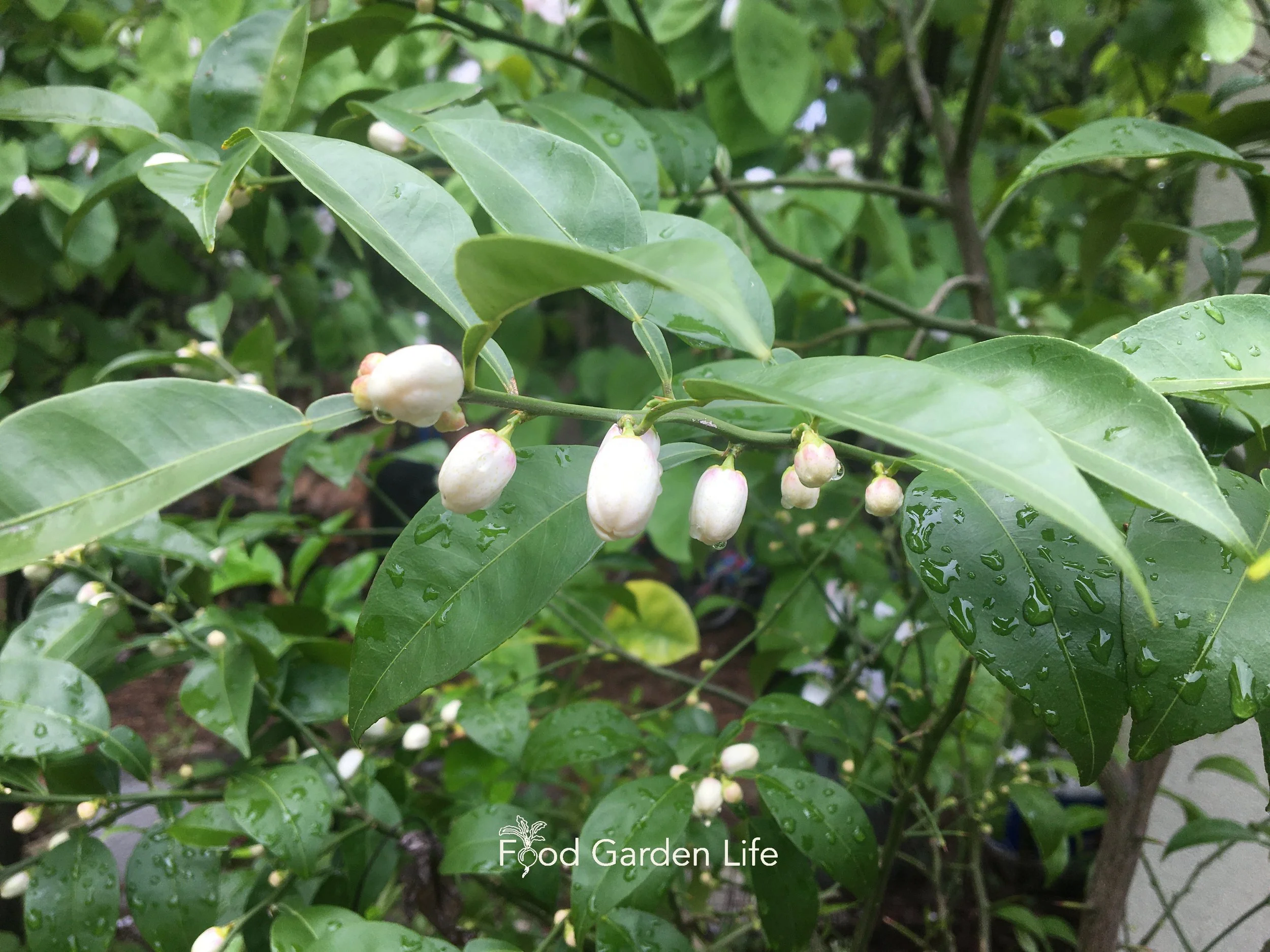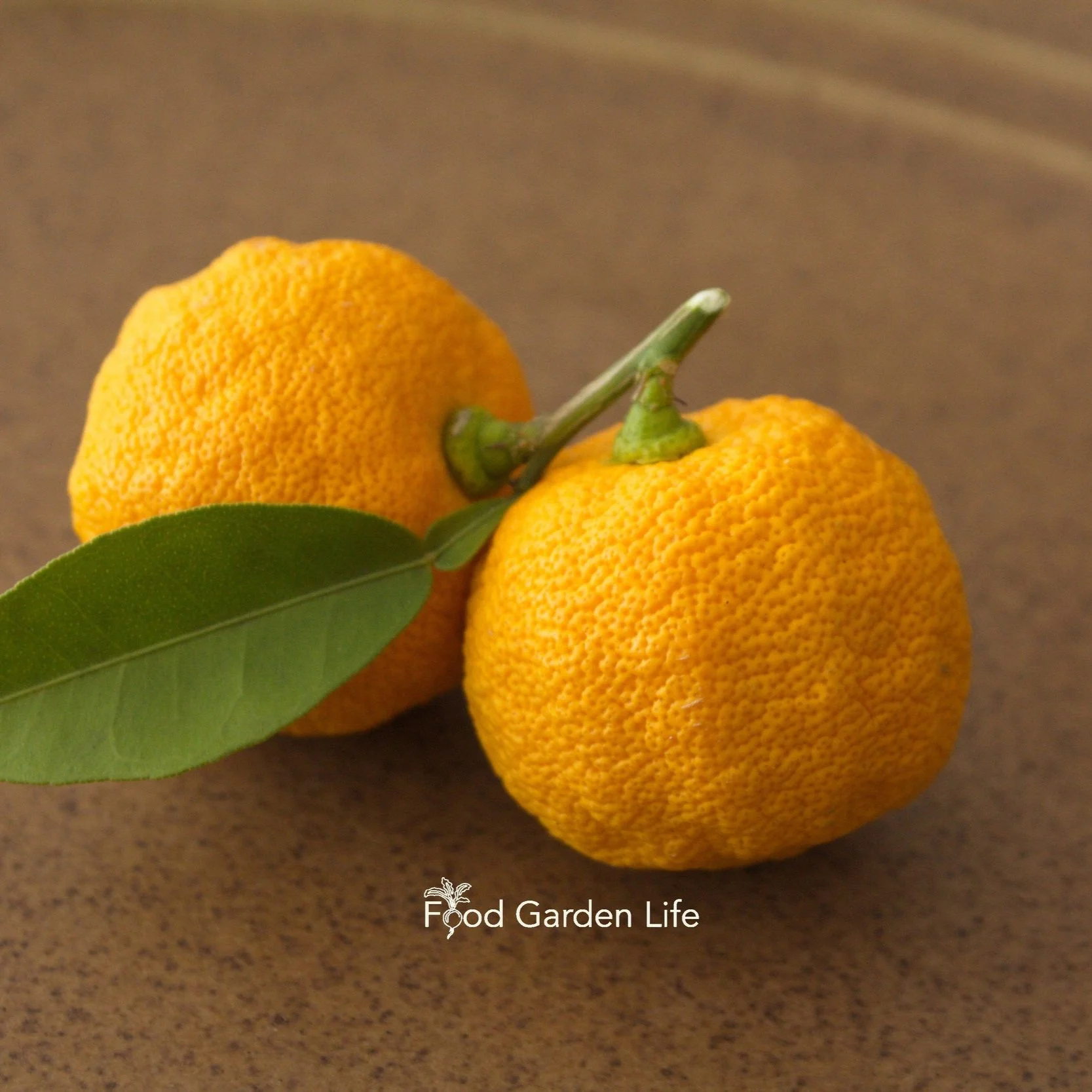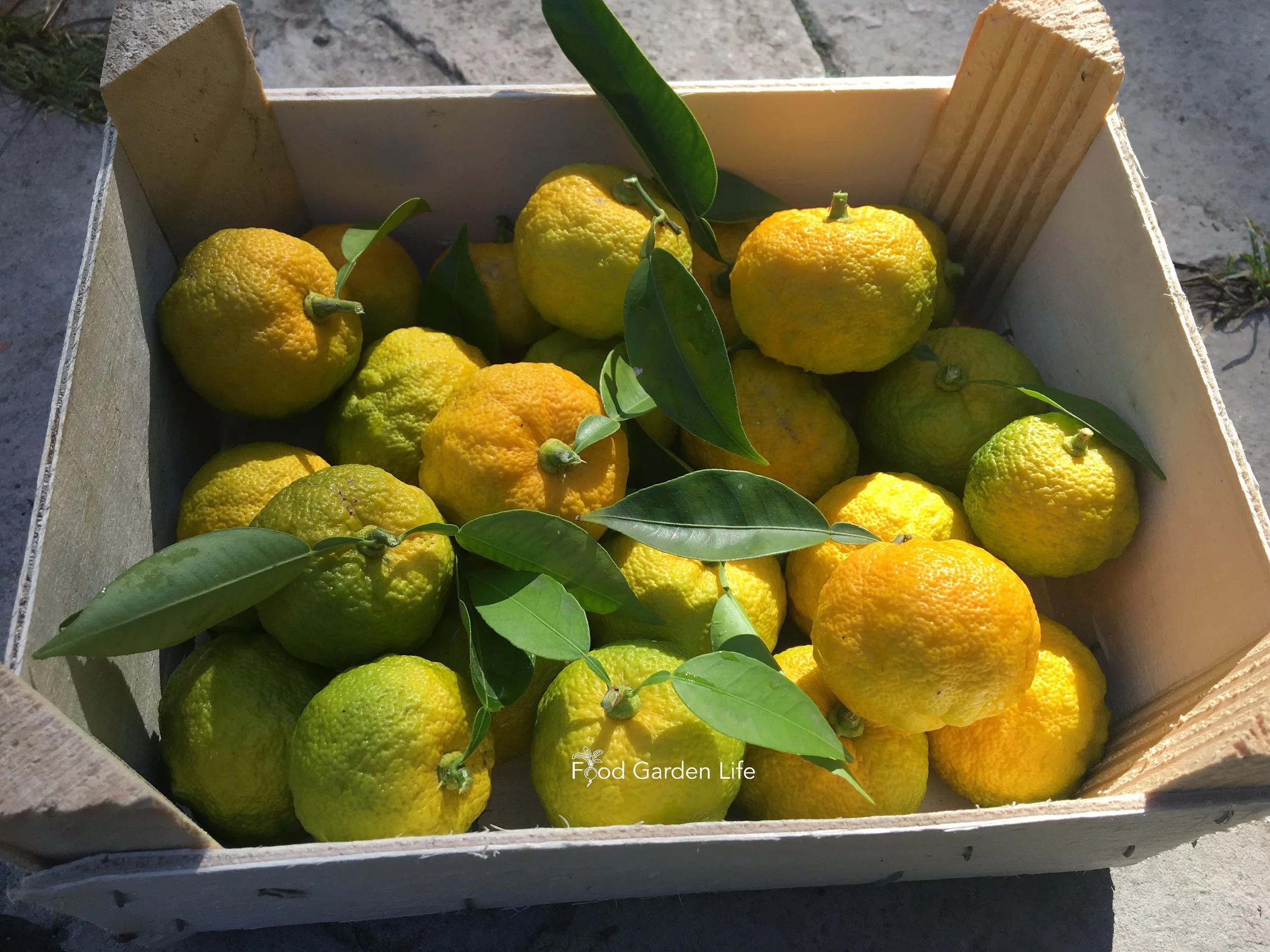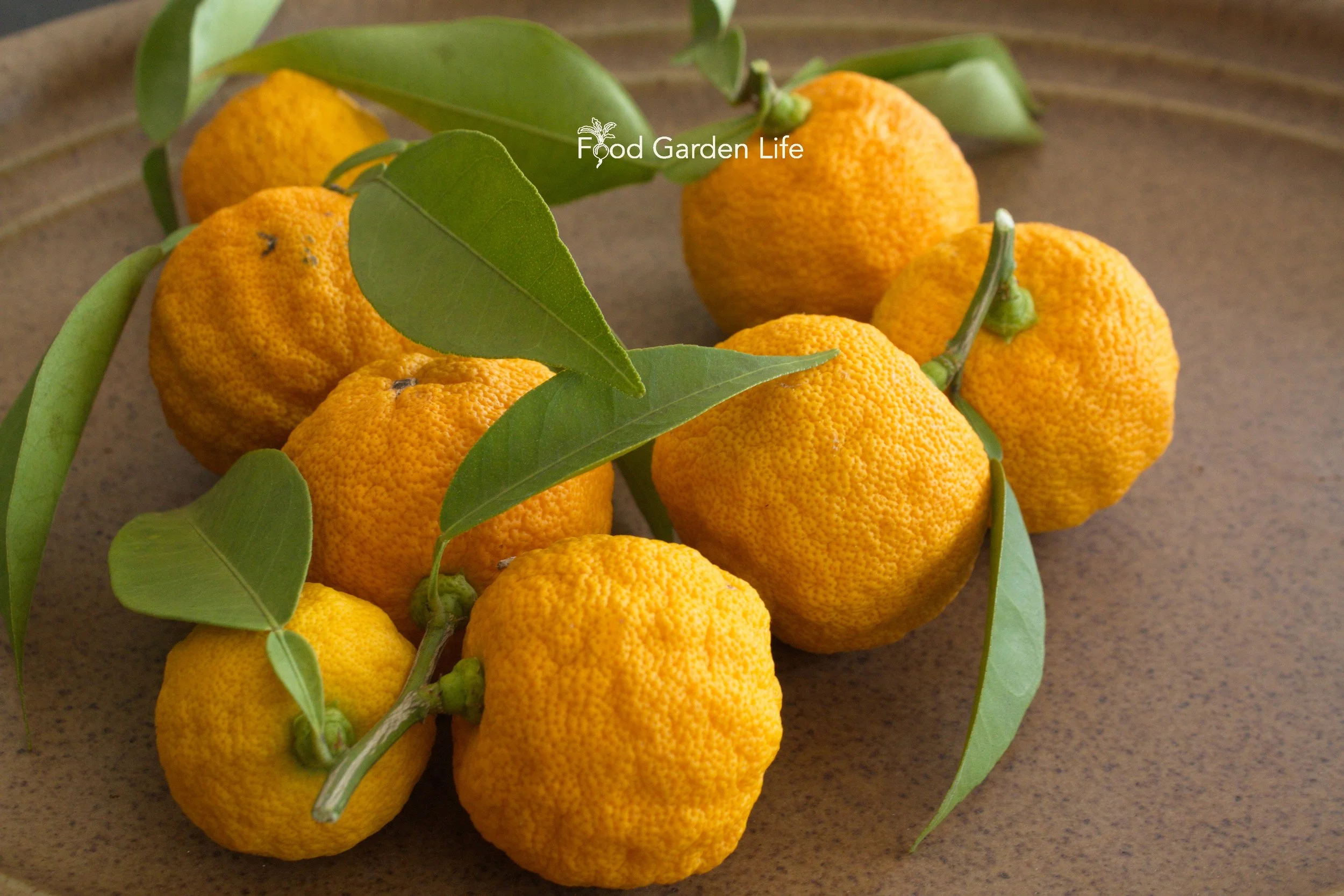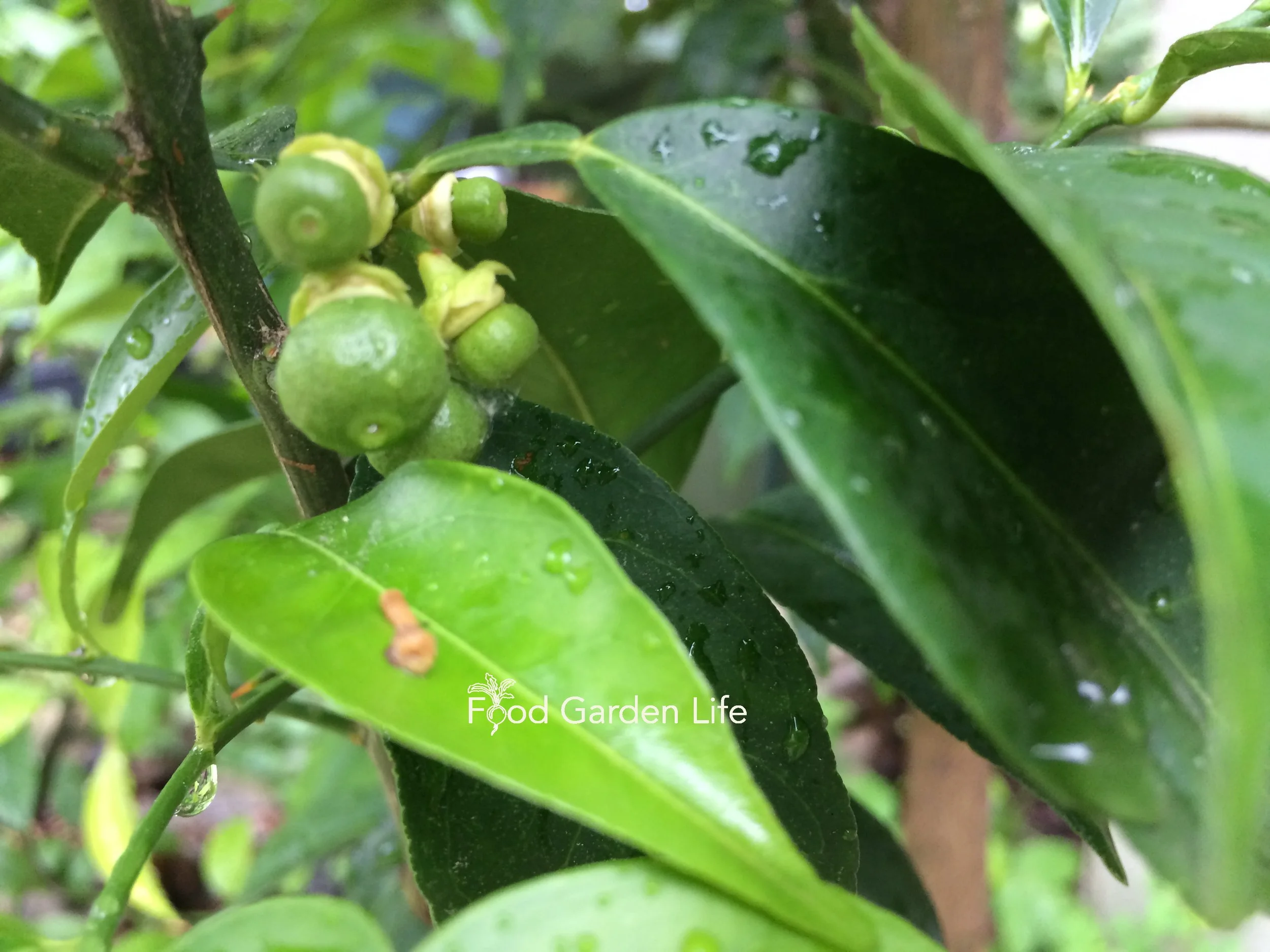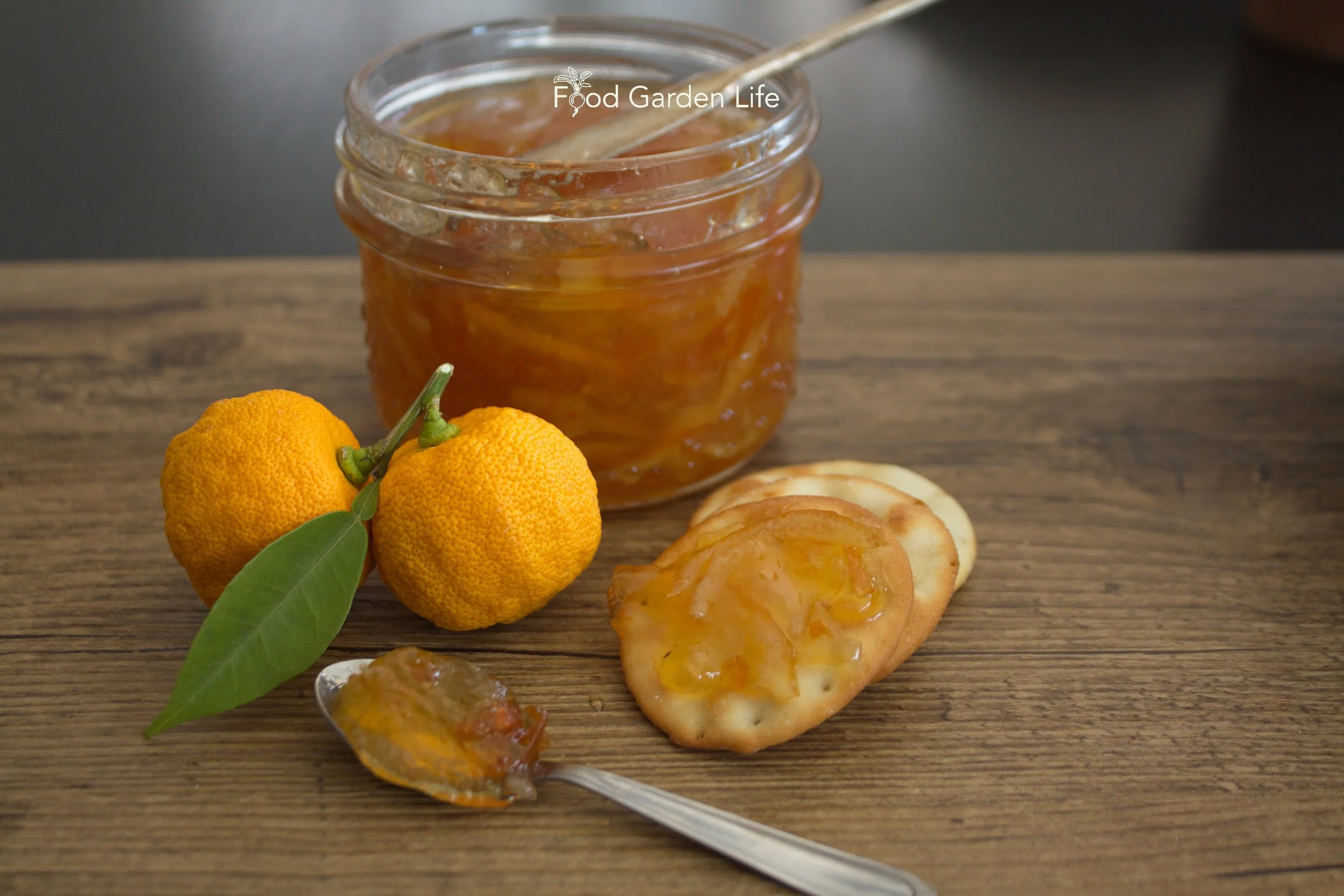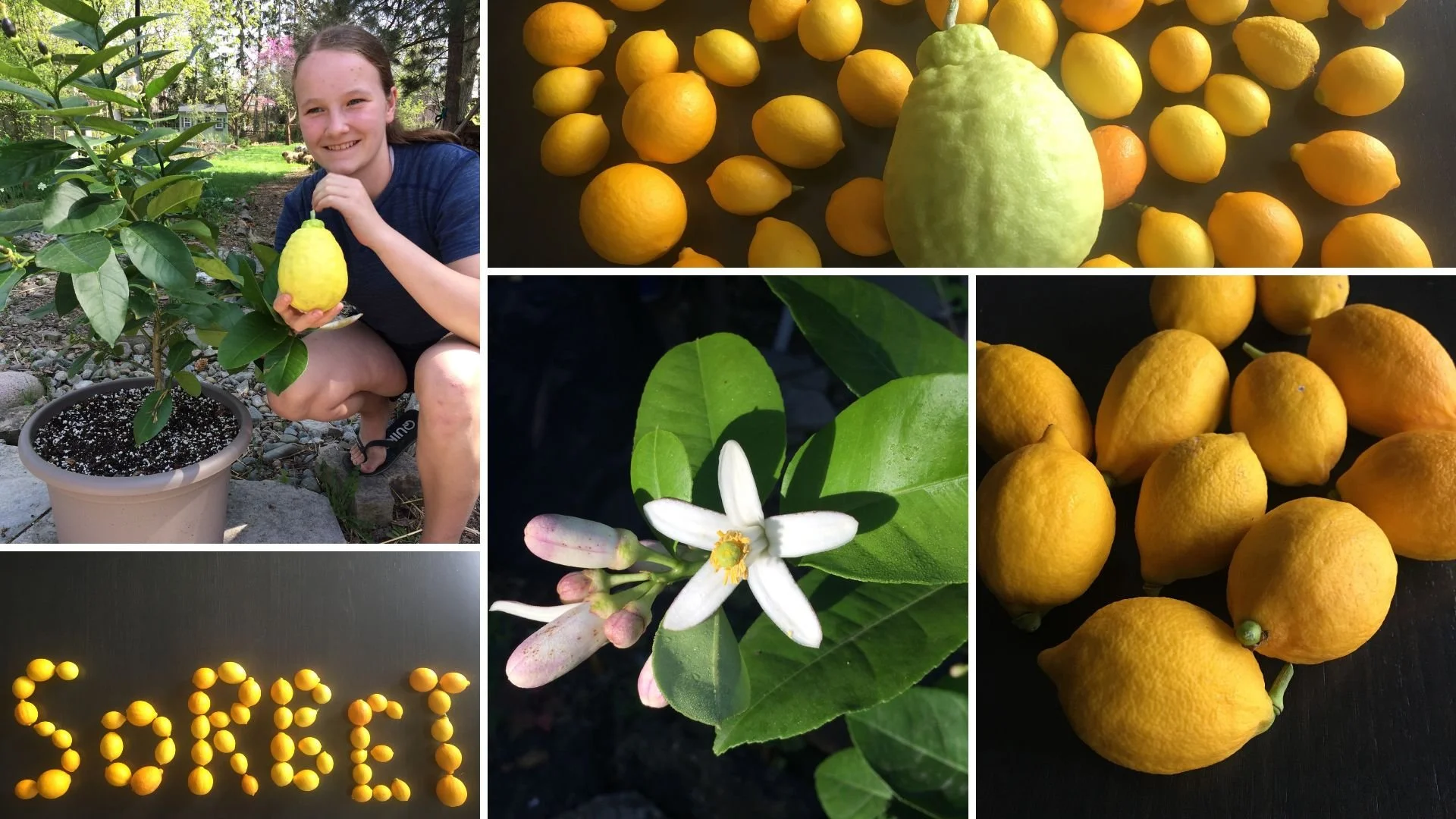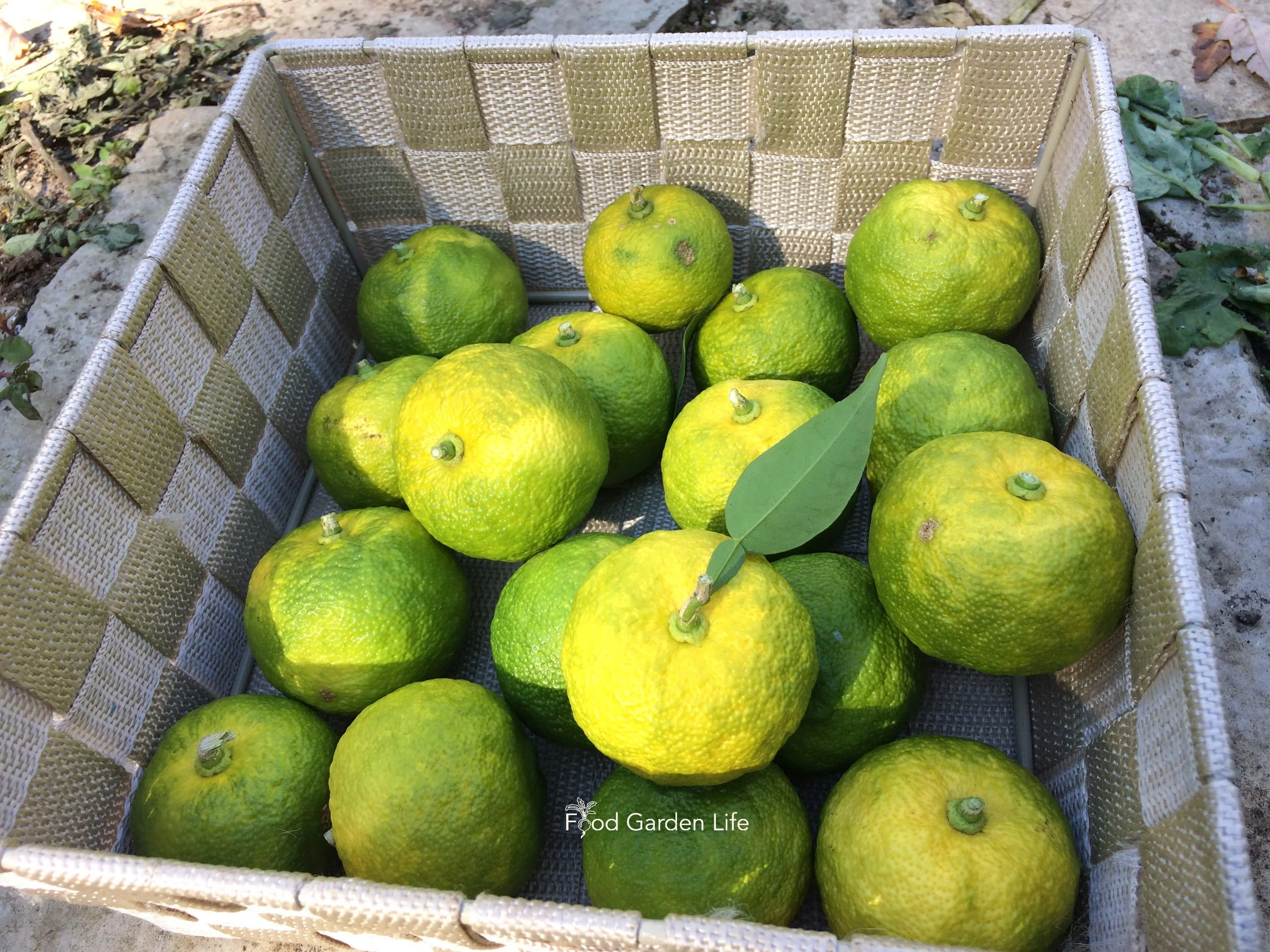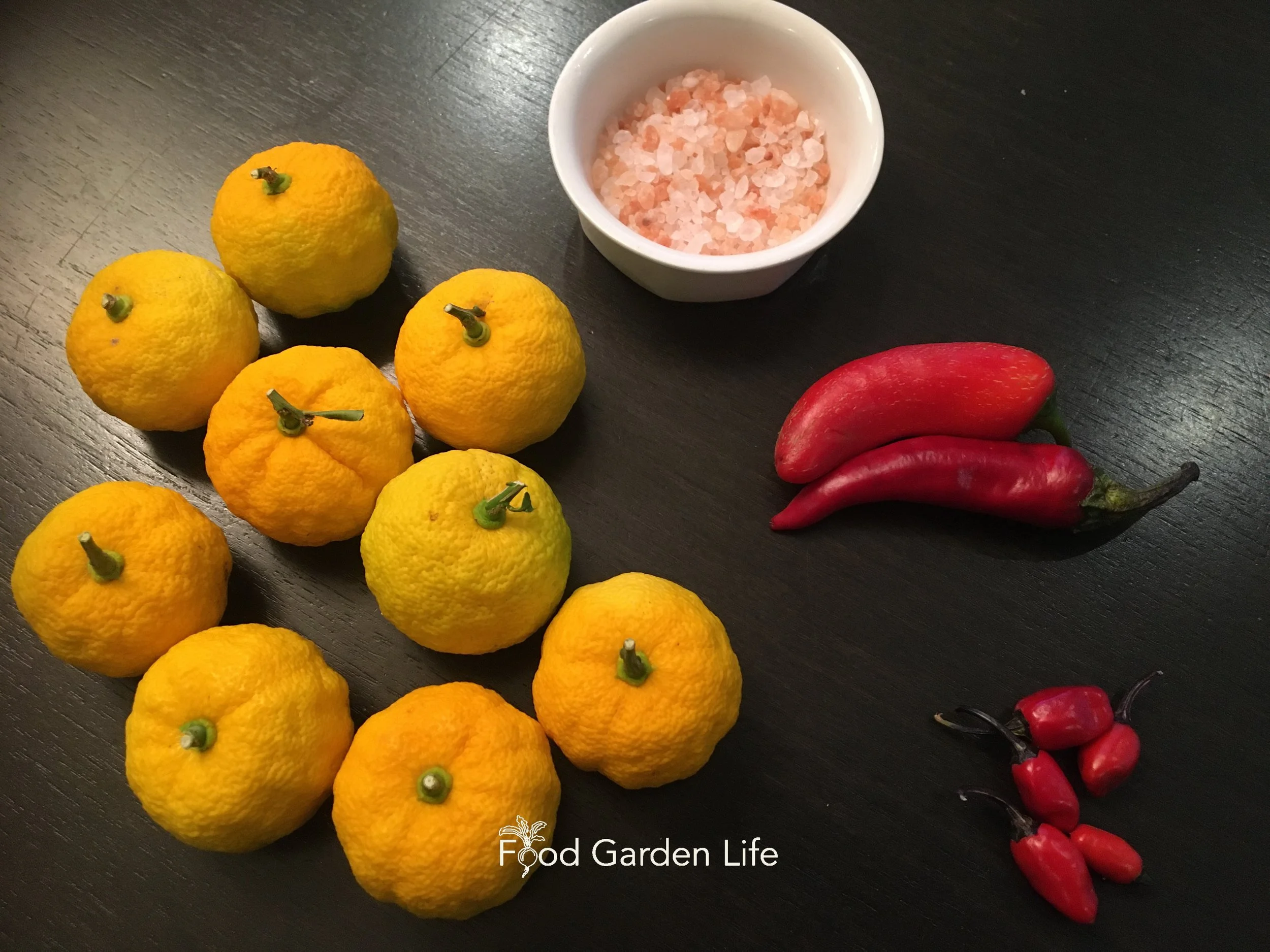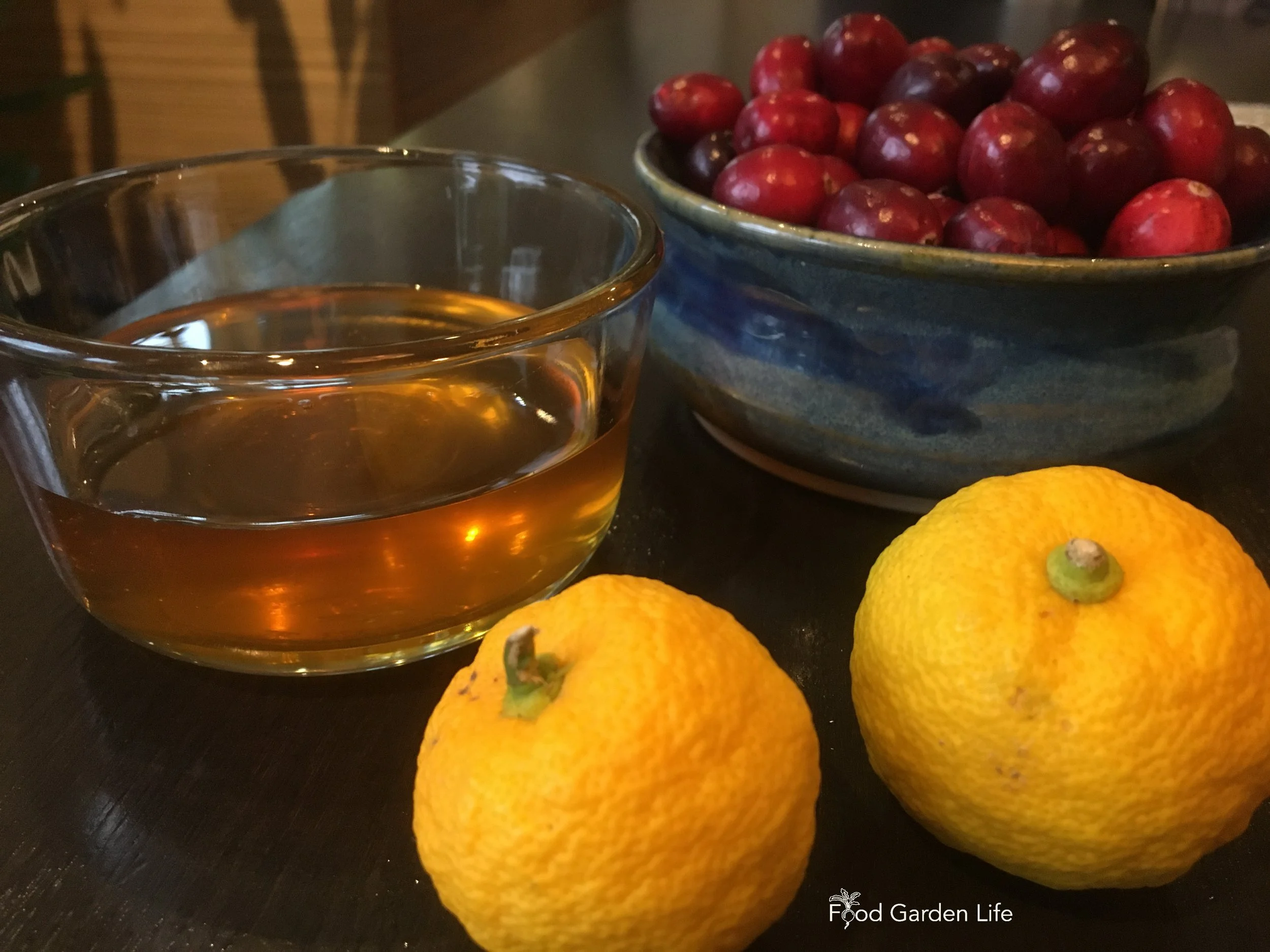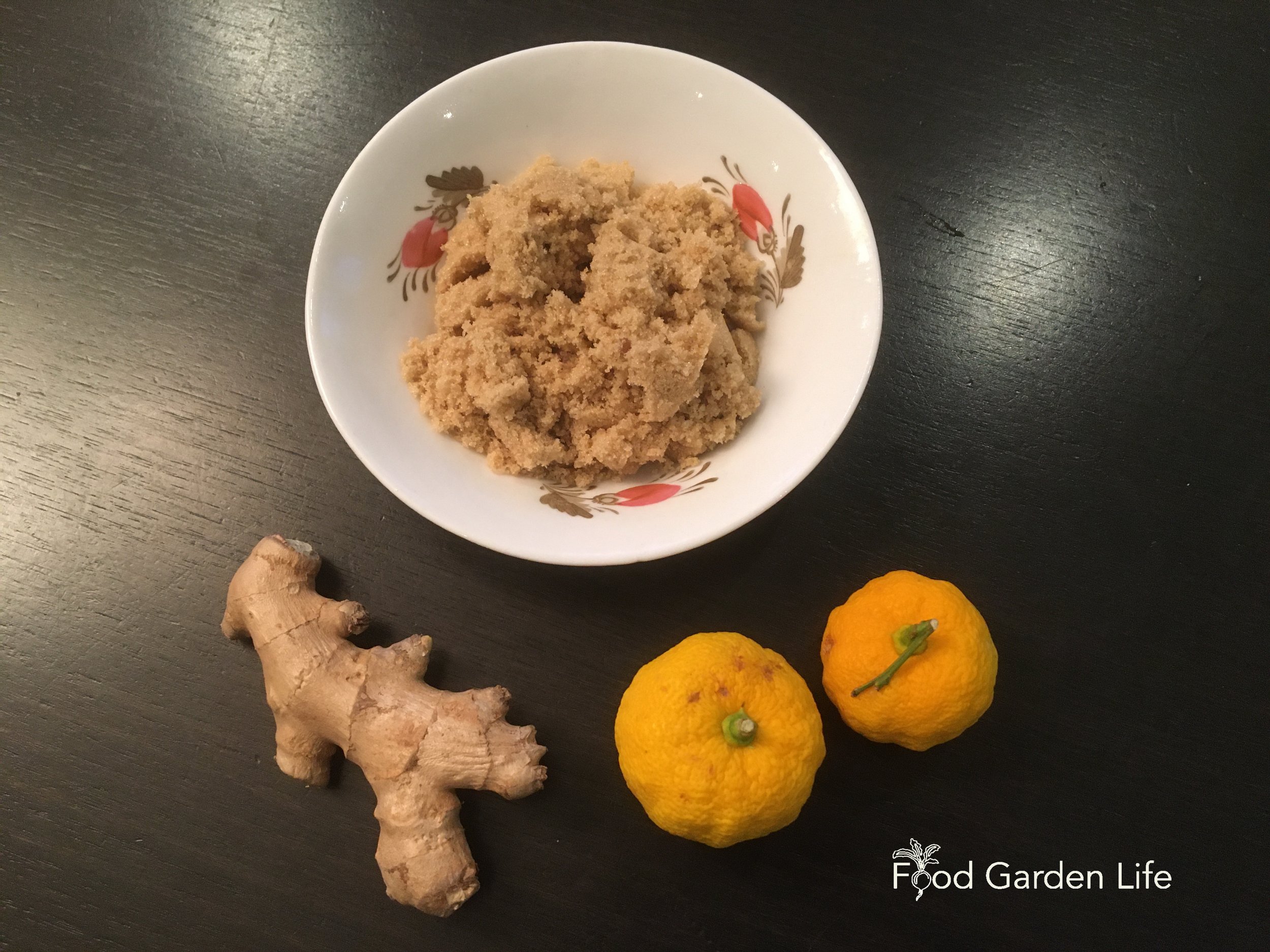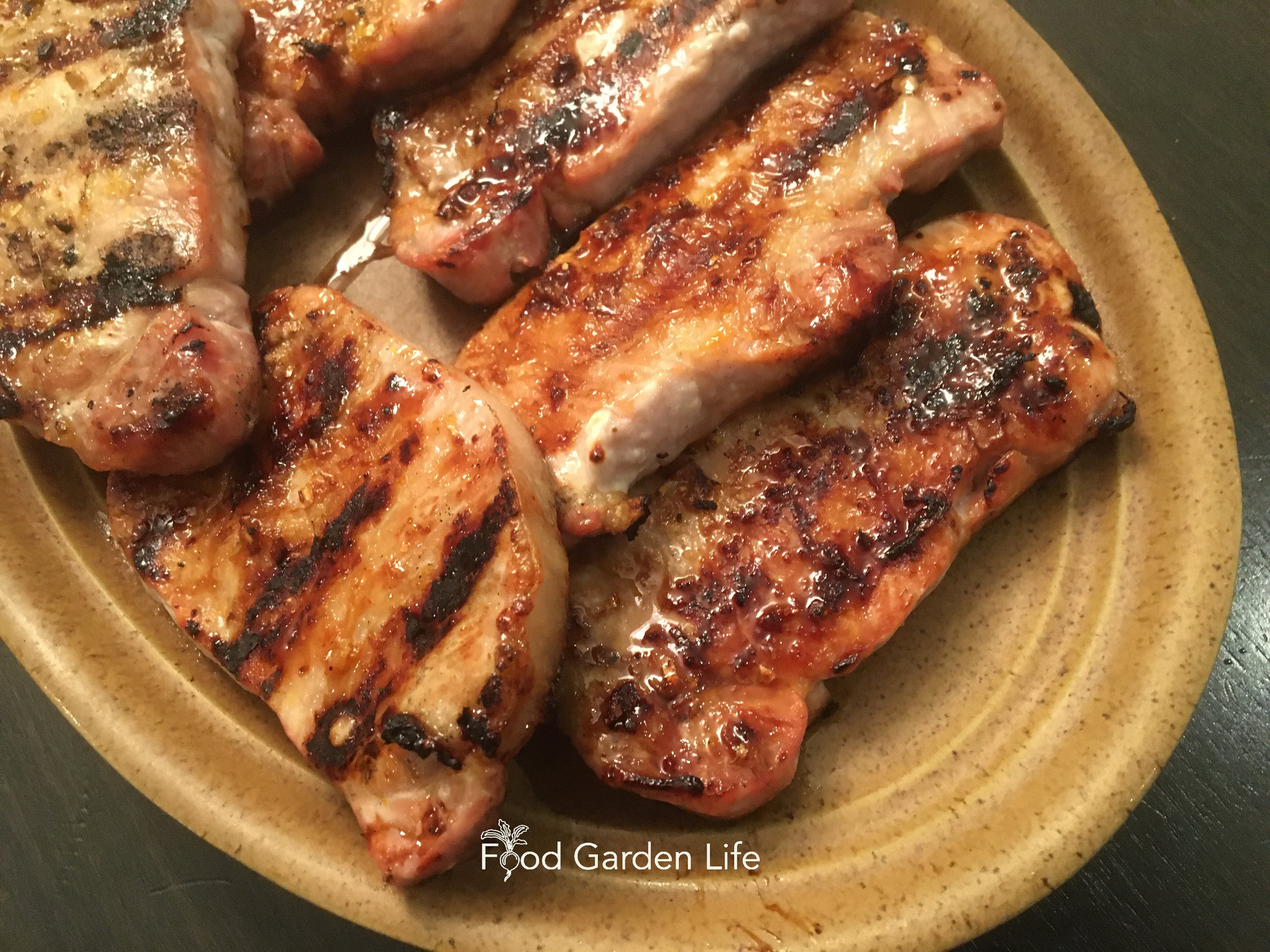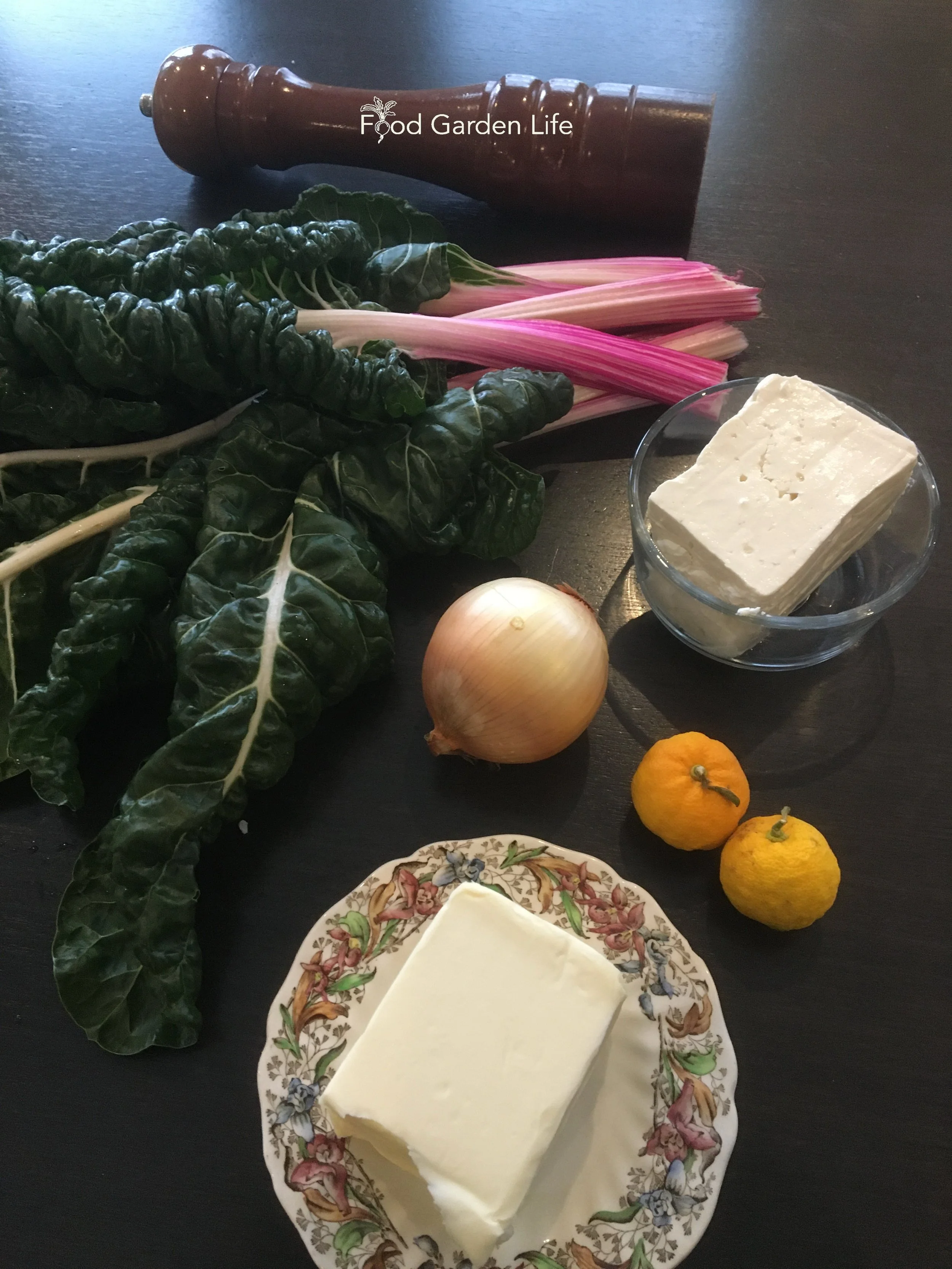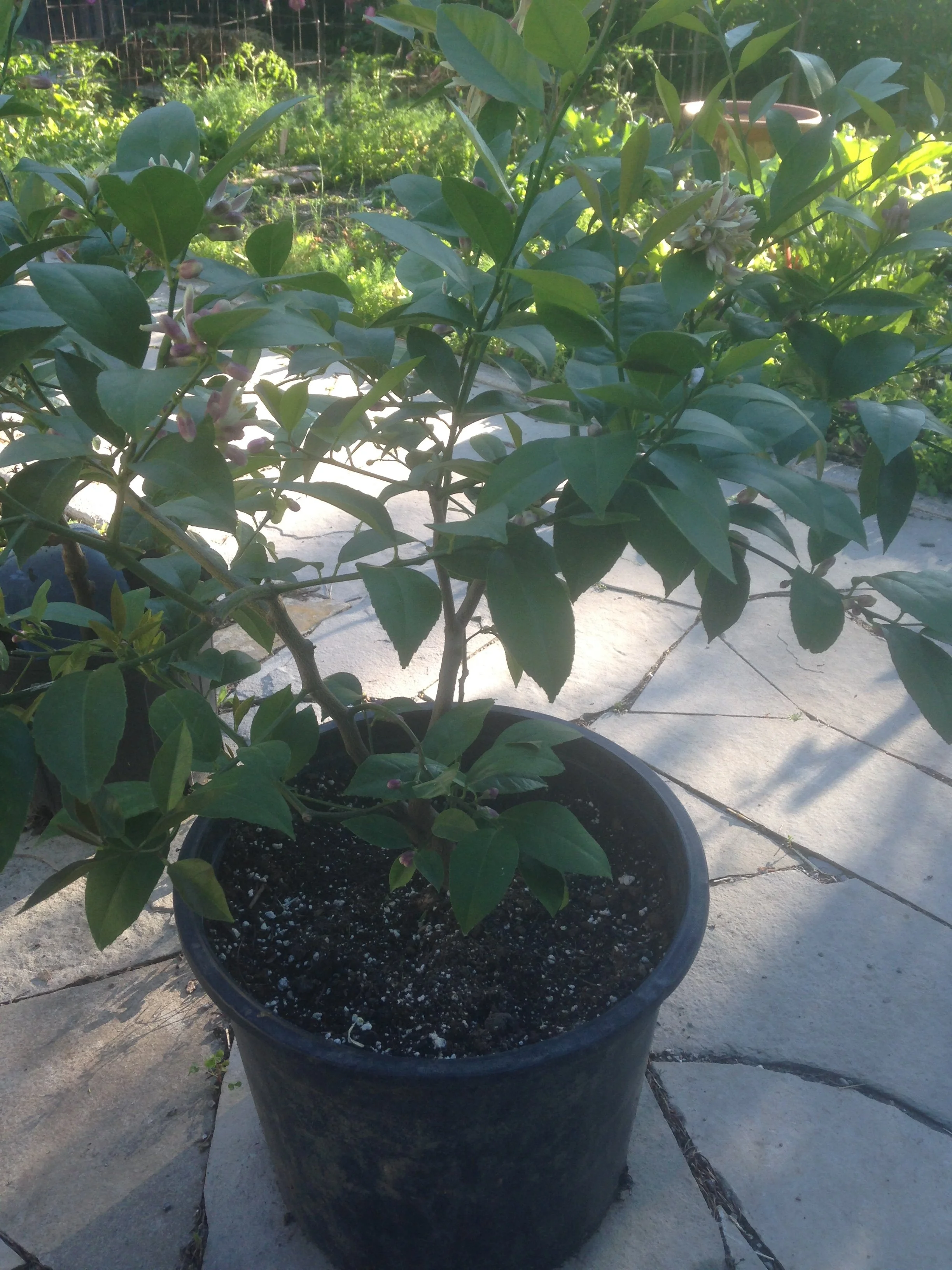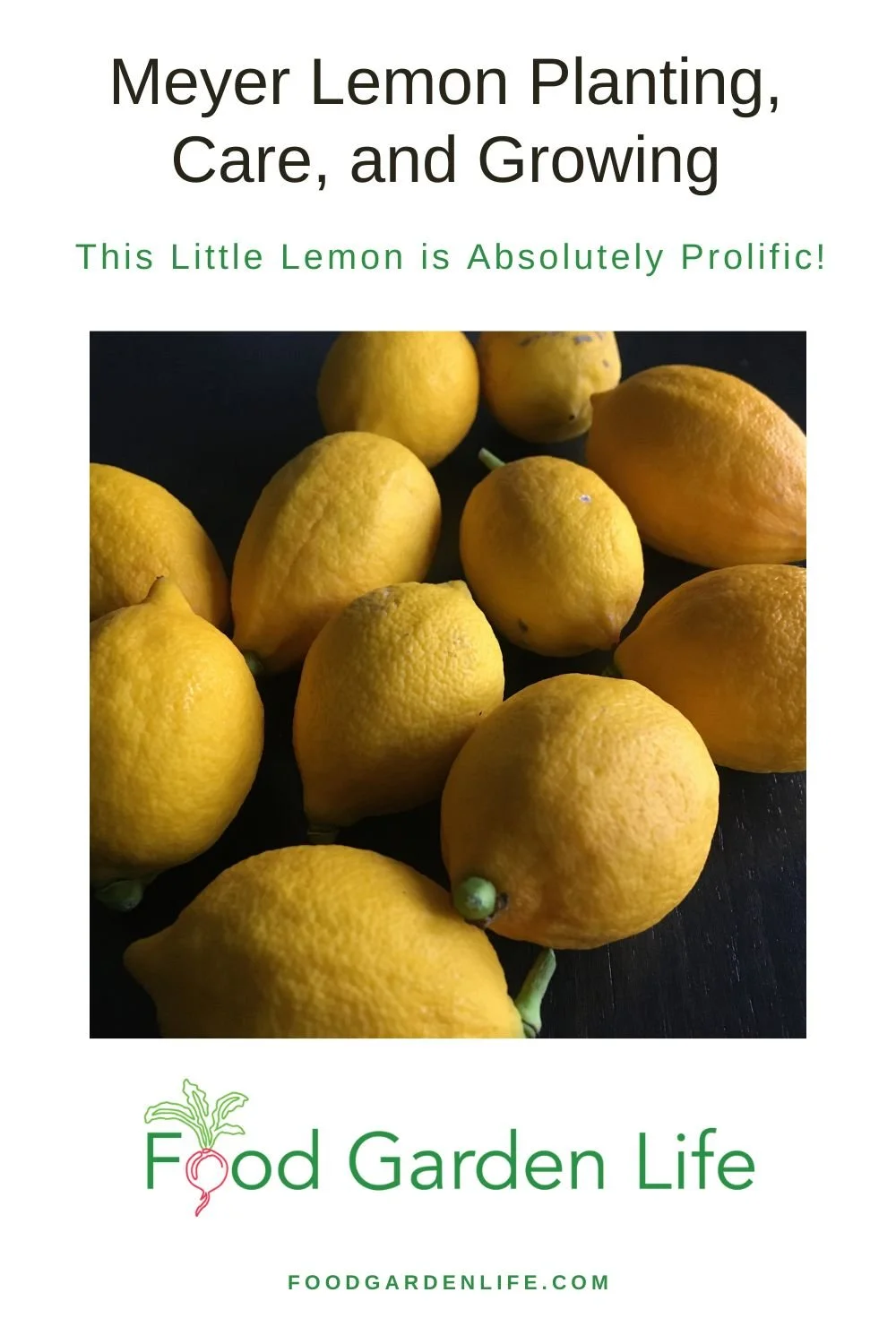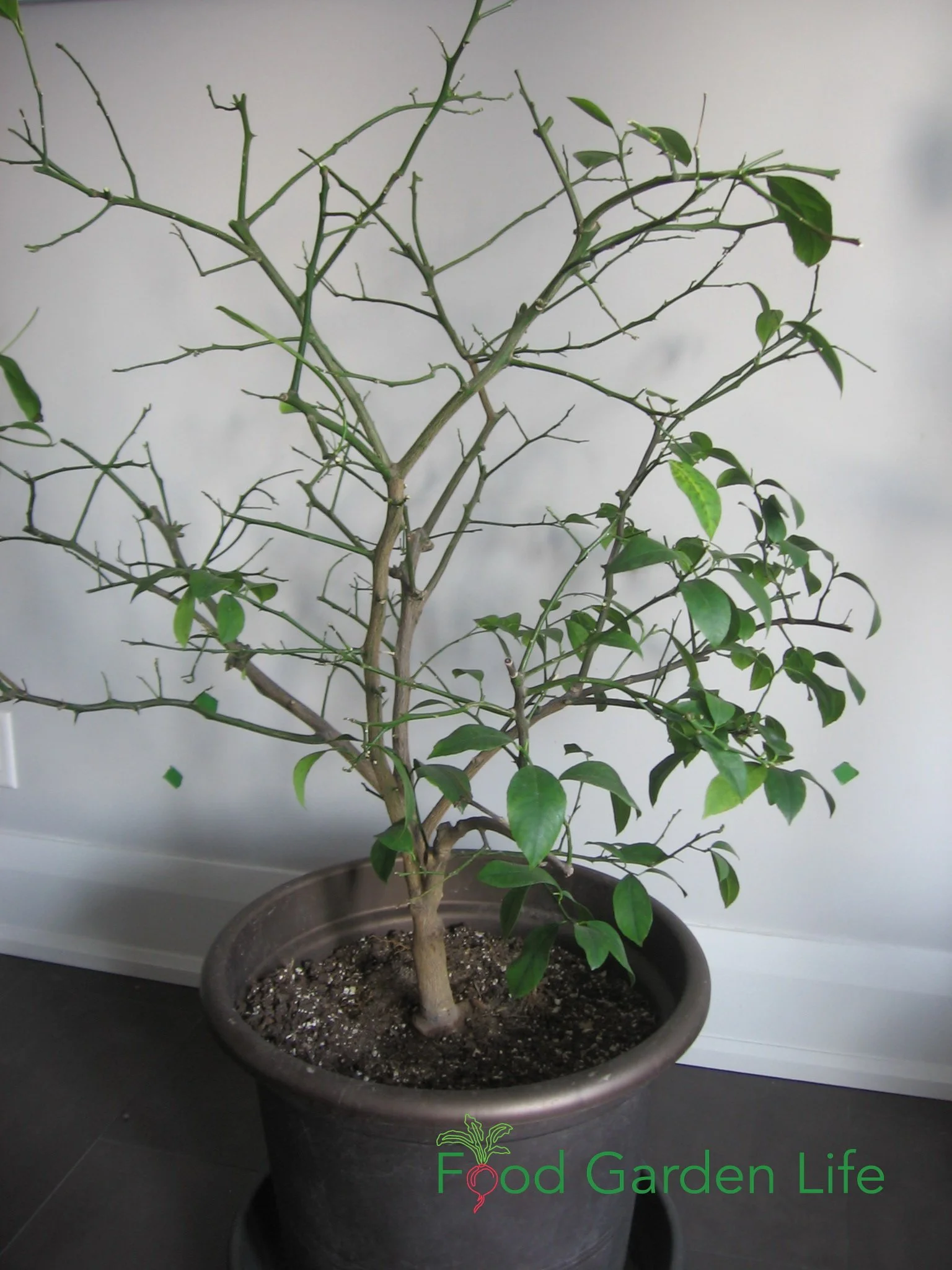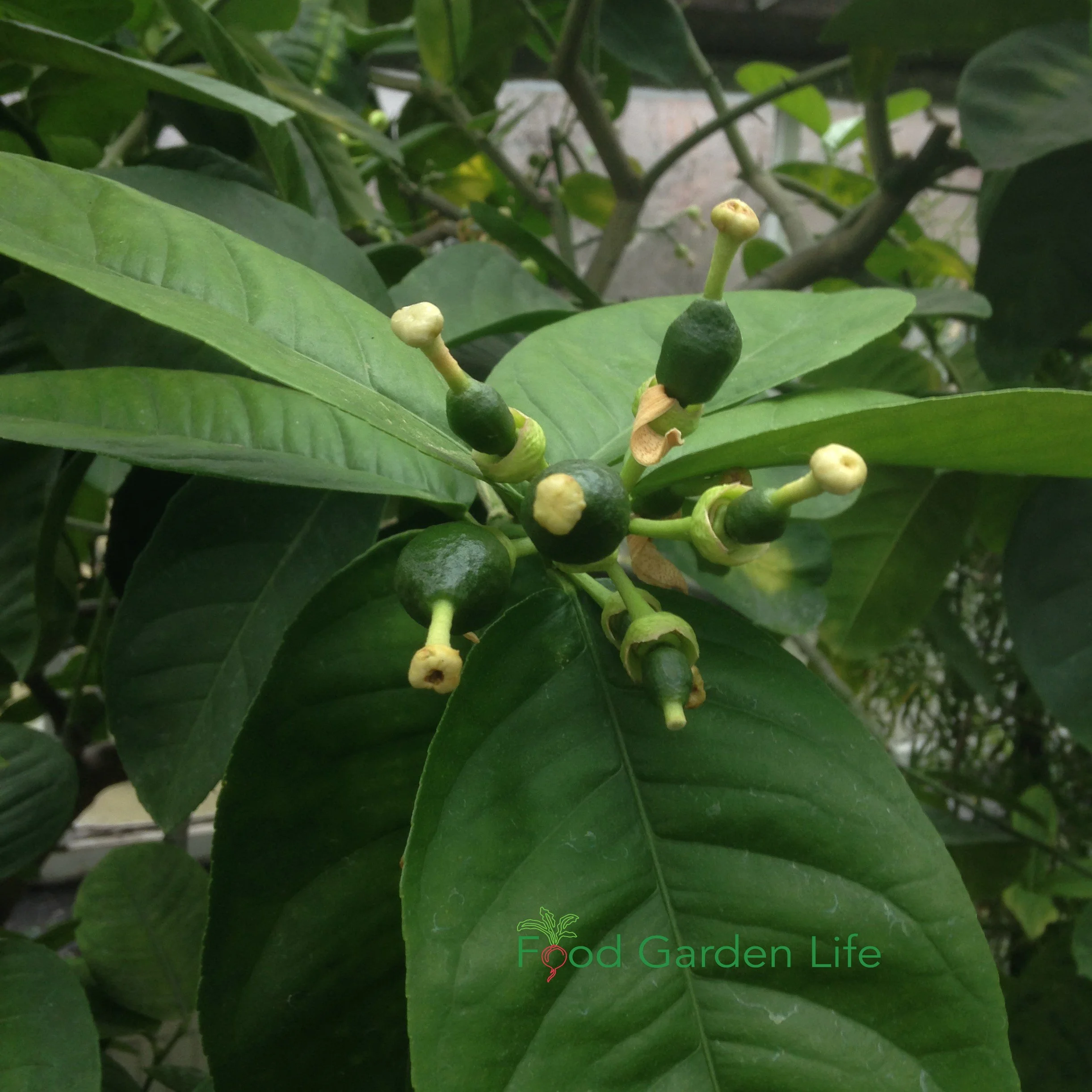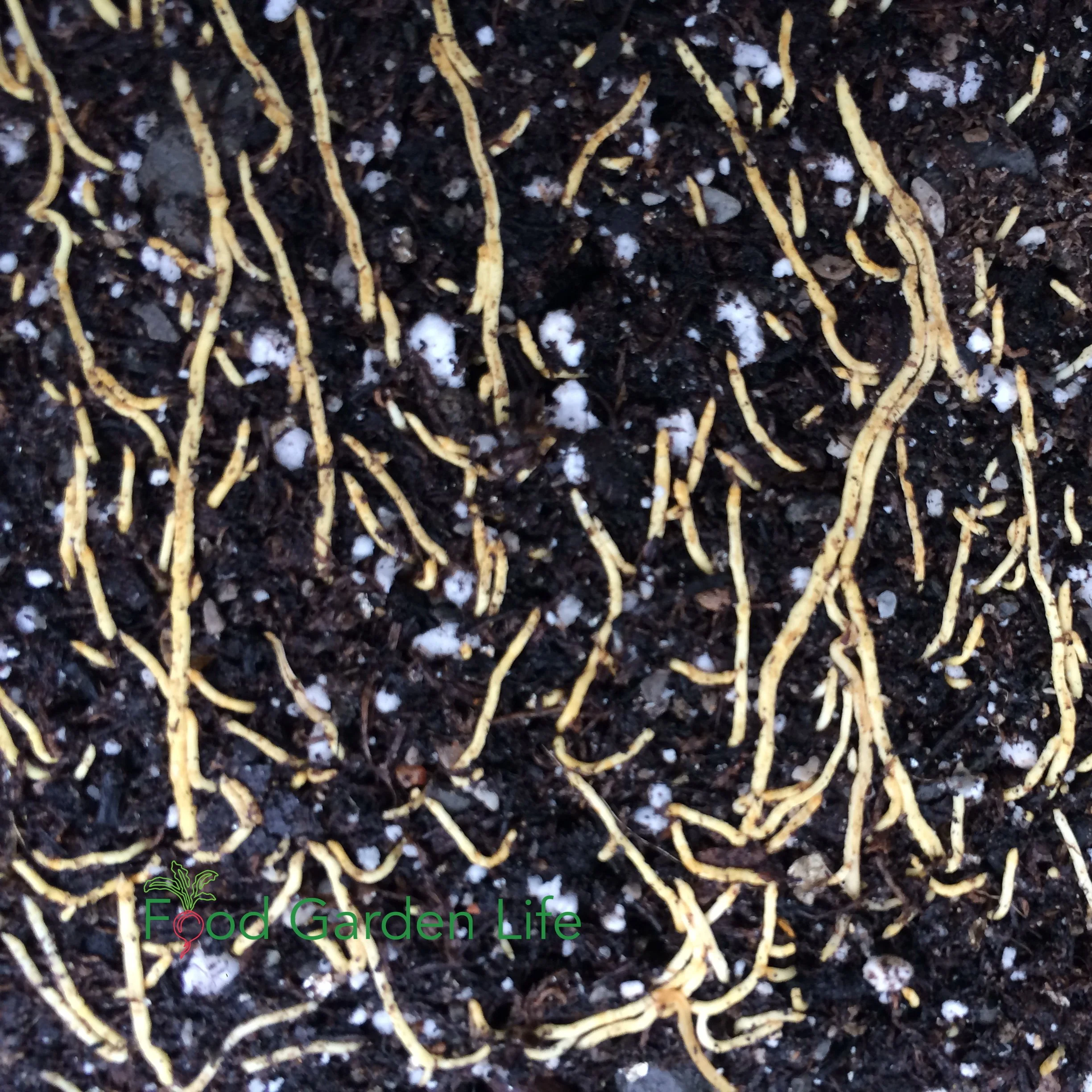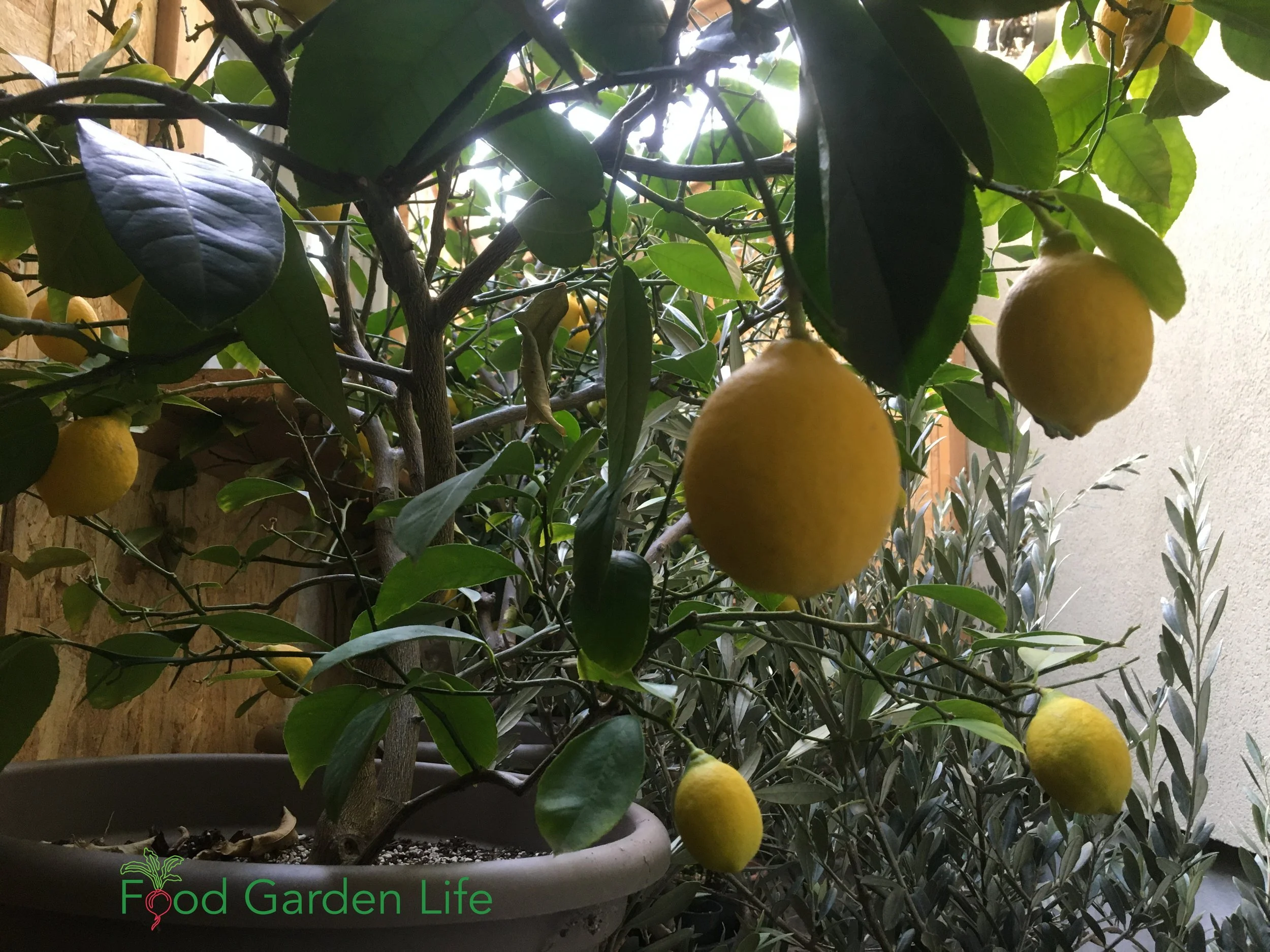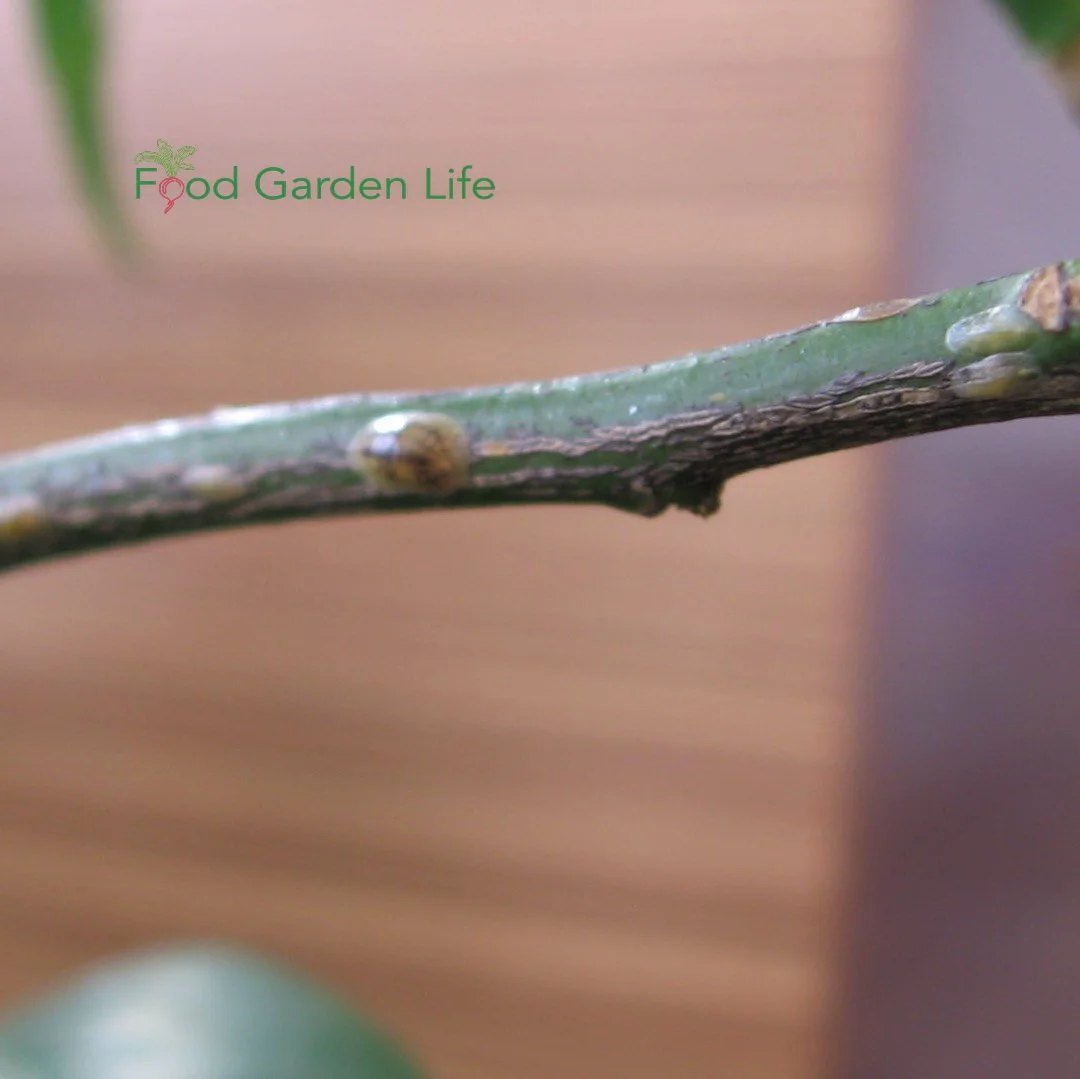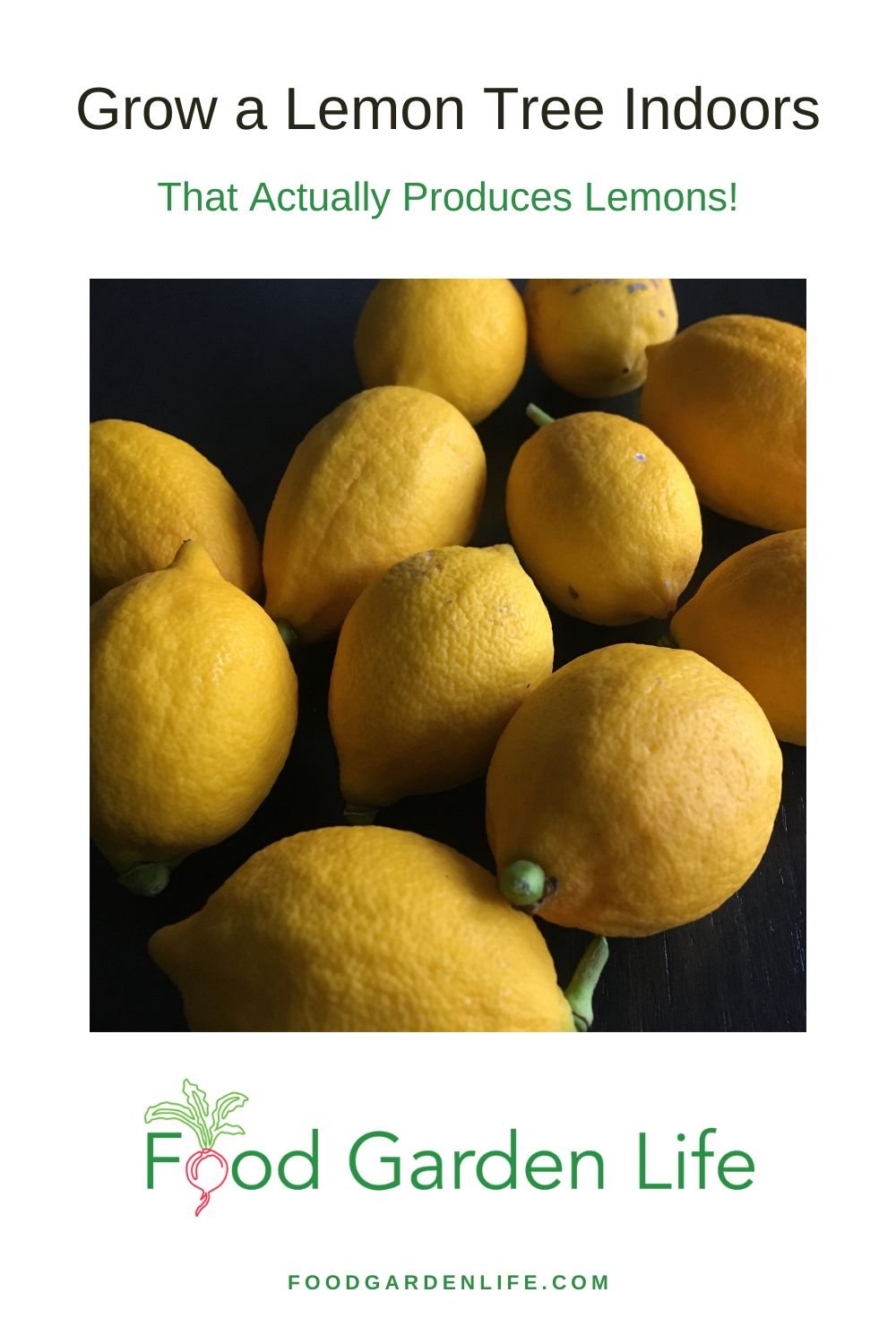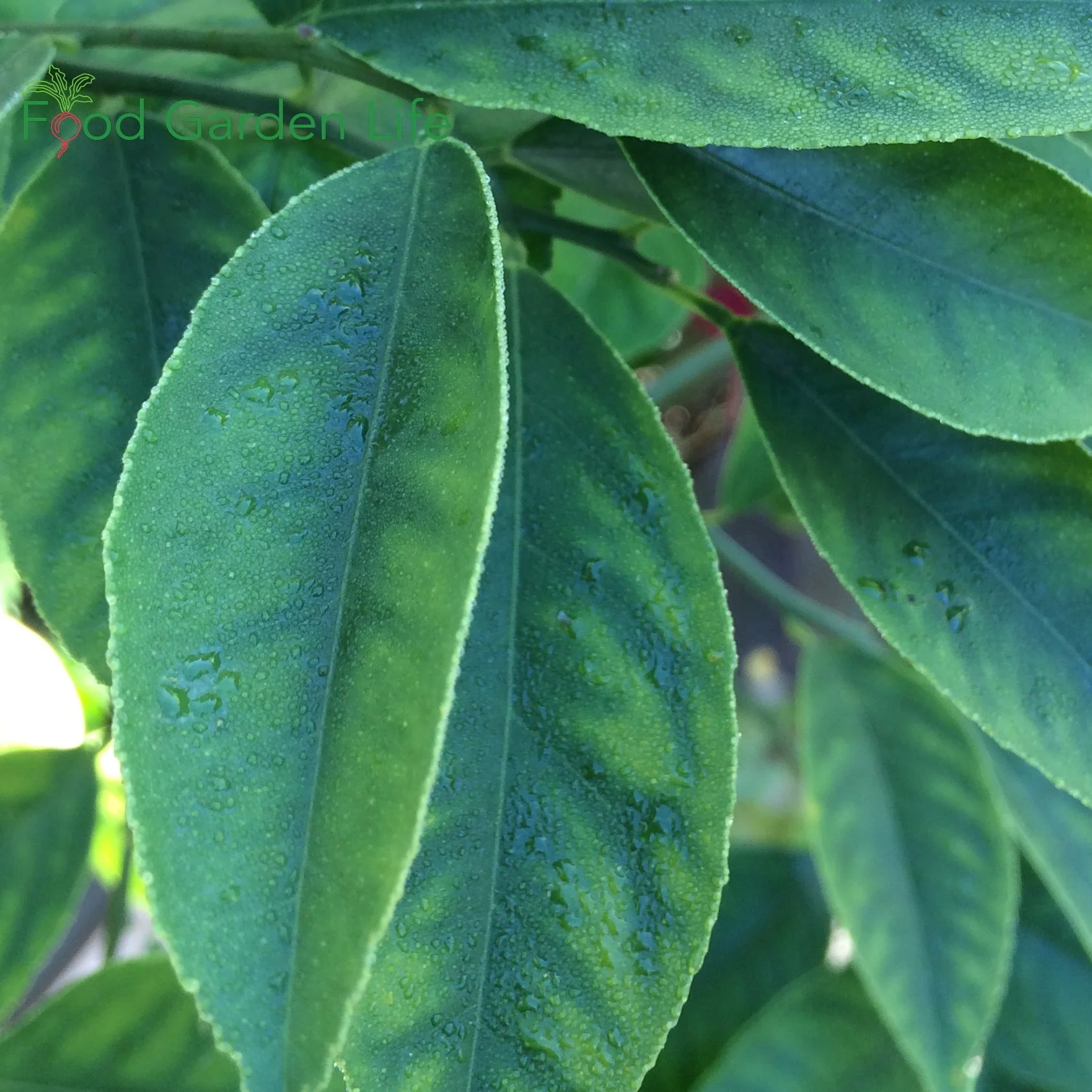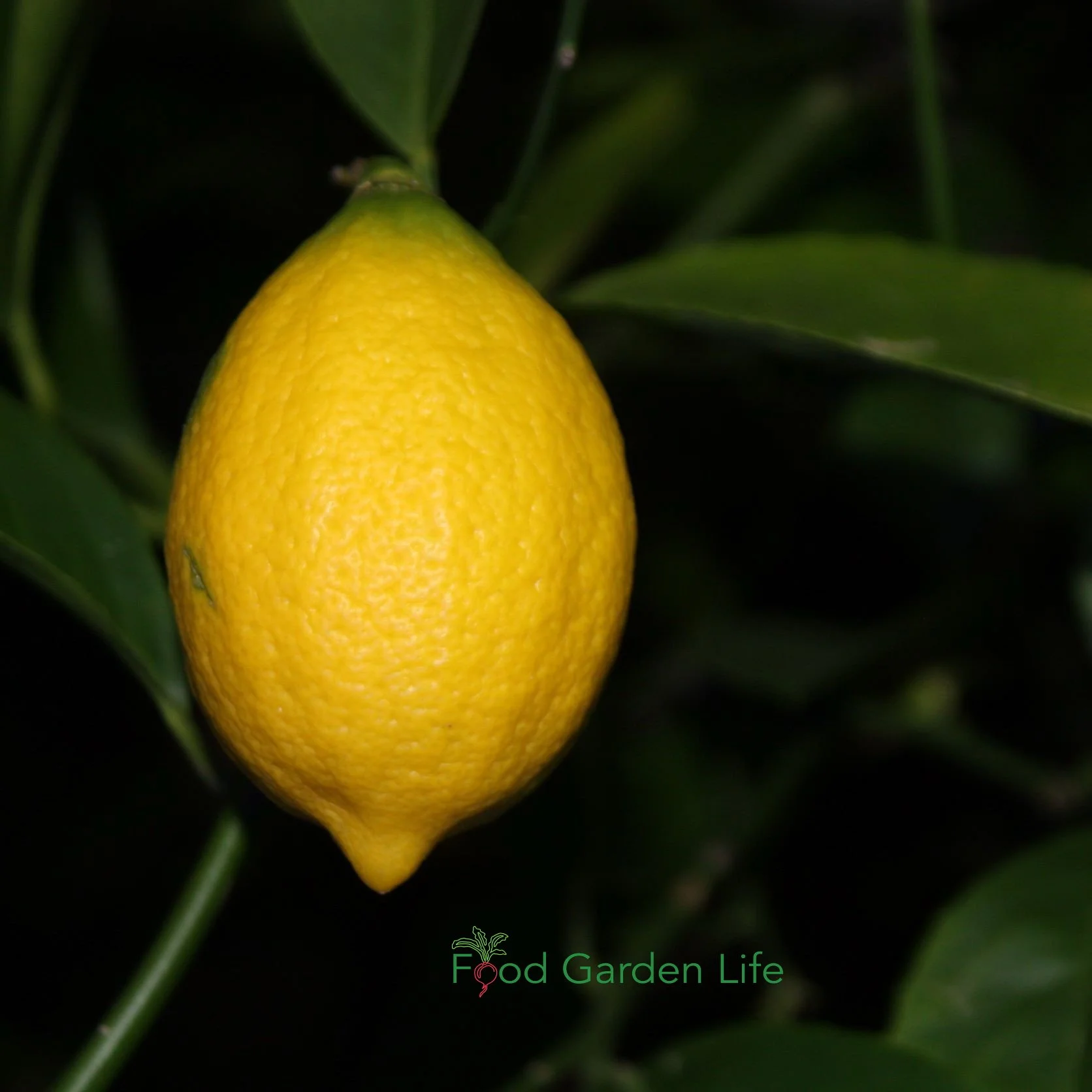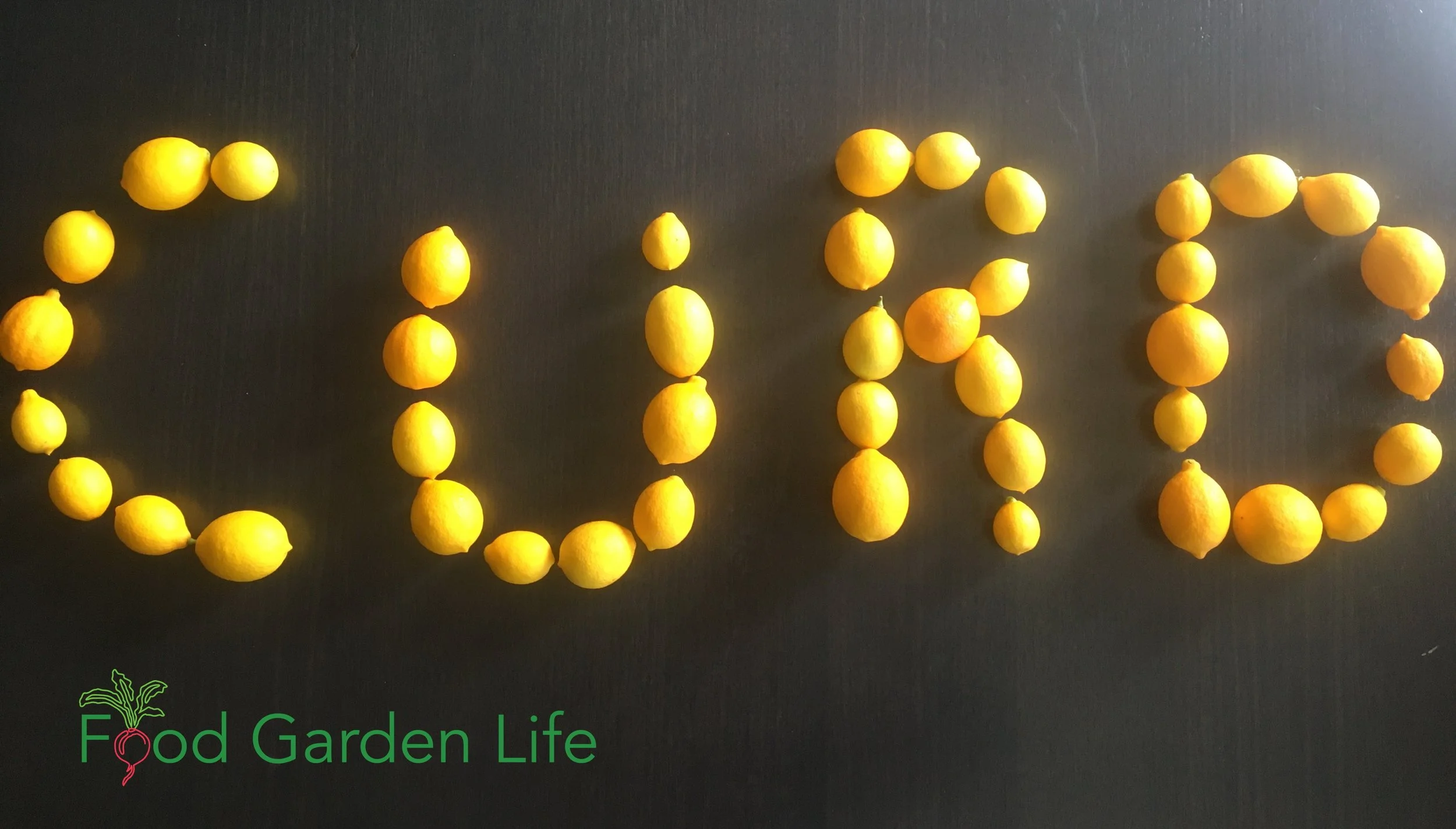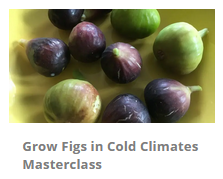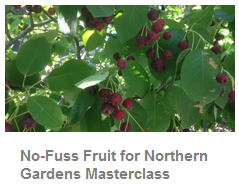
This Cold-Tolerant Citrus Fruit is Super Fragrant: Yuzu
Yuzu: This Citrus is a Rare and Fragrant Foodie’s Delight (And You Can Grow it in a Cold Climate!)
By Steven Biggs
Grow Your Own Fresh Yuzu Citrus
Yuzu fruit, also called yuzu citrus, is very cold tolerant.
This citrus fruit looks similar to a mandarin orange. But scratch the rind and you’ll quickly know it’s not.
Don’t pop it in your mouth, either. This isn’t a peel-and-eat fruit.
Unlike a mandarin it’s:
Pucker-up sour
Super seedy
Delightfully aromatic
Chefs and food enthusiasts know all about yuzu. Yuzu juice and yuzu zest are prized.
But good luck finding fresh yuzu fruit for sale—or finding a yuzu plant at a garden centre. The gardening world hasn’t caught up with the culinary world when it comes to yuzu.
It’s too bad, because yuzu is easy to grow. And—for cold-climate gardeners—it’s even more cold tolerant than lemon.
With its fragrant flowers and glossy leaves, it’s a fine addition to the cold-climate kitchen garden. Grow it as a potted plant—or an in-ground plant in borderline zones.
Keep reading this article to find out how to grow and harvest your own yuzu in a cold climate.
What is Yuzu
Pin this post!
Yuzu (Citrus junos) is a very cold-tolerant citrus plant. The cold-tolerance is no surprise given its pedigree: It’s thought to be a naturally occurring hybrid of two other cold-tolerant citrus fruits, mandarin and ichang lemon.
Yuzu plants are fairly upright, making them easy to grow as a single-stem potted tree. I keep my potted yuzu at about 1.5 metres (5’) high.
When the fragrant white flowers come out in the spring, they’re a magnet for pollinators. Bees love them.
Unlike mandarin, yuzu peel is a bit pebbly.
Yuzu flowers are fragrant—and are a magnet for pollinators.
Like most citrus fruits, yuzu is evergreen, meaning it has leaves on it year round. (Unless you really stress it out, see below.)
Acid Citrus Fruits for Cold Climates
When it comes to growing citrus fruit in cold-climate gardens, here’s a great way to set yourself up for success: Start with “acid” citrus.
Acid citrus are the sour ones like lemon or lime—and yuzu
For sweet citrus, think navel oranges and grapefruit
Yuzu fruit is a bit pebbly, not smooth like a mandarin.
The reason to start with acid citrus fruit is that they can ripen in a cold-climate garden with cool or short summers. Sweet citrus need hot summers with sustained heat to ripen...and don’t always ripen.
Yuzu is an acid citrus. Perfect in colder climates.
Yuzu Tree Cold Hardiness
Yuzu Minimum Temperature
Yuzu fruit is an acid citrus, making it a good choice where summers are short or cool.
I’ve never pushed the lower temperature limits here in my Canadian Zone 6 (USDA Zone 5) garden because my yuzu tree spends the winter in a cold greenhouse, kept near freezing.
But yuzu can survive much colder temperatures than that.
Yuzu hardiness—like any plant hardiness—isn’t an exact thing. Hardiness guidelines vary, depending on who you ask. You’ll see recommendations down to -10°C (14°F) –and colder!
But one thing is for sure: As citrus go, yuzu is very cold-tolerant.
The reason for the varying minimum temperature recommendations is that hardiness is affected by a few things.
Here are a few things that affect the hardiness of a yuzu (or any plant!)
The rootstock used for grafted yuzu trees
Young trees are more tender than mature trees
New growth is affected by cold before older, woodier stems
The duration of cold temperatures
How sheltered or exposed the tree is
How many degrees the temperature drops
Container trees are more susceptible to cold than in-ground trees because the temperature around the roots fluctuates more
Yuzu Cold Tolerance: Bonus Point!
Covering everything from lemon varieties, to location and watering, to pruning and shaping, to overwintering, dealing with pests, and more—and including insights from fellow citrus enthusiasts—this book will give you the confidence you need to grow and harvest fresh lemons in cold climates.
Some citrus (e.g. lemon) bloom on an ongoing basis—so a plant can have unripe fruit going into winter. This can be fun if it’s indoors and you want to pick lemons over winter.
But the fruit can’t get as cold as trees; when the fruit freezes it spoils.
That means that the temperature at which the fruit freezes (around -2°C, 28°F) becomes the minimum winter temperature for cold-climate gardeners growing lemons outdoors.
Find out how cold lemon fruit can get over the winter.
Unlike lemon, yuzu has a spring bloom and fall ripening…so there is no fruit on the tree over the winter. That give you a wider temperature range for overwintering. You’re not constrained by the freezing temperature of the fruit.
How to Grow Yuzu
Grow Yuzu in a Pot
Yuzu does well as a potted plant. With its upright growth, it’s easy to manage.
Here are a couple of top tips for growing yuzu as a potted plant:
Use a potting soil that drains well
Keep the soil moist, but not wet
Potted Plant Yes: Houseplant No
Just because it grows well in a pot doesn’t not make it a good houseplant.
It’s not suited as a houseplant over the winter. Centrally heated homes are too warm. Instead, pick a bright and cool spot for winter. If you have a sunroom or a cool greenhouse, that’s perfect.
(I’ve also stored my yuzu in a cold, dark garage. The plant isn’t growing in cold weather—so it will tolerate the dark.)
No Place in Winter?
Not sure where to put a potted yuzu for the winter? A friend has a spare bedroom and turns off the heat there over the winter. It has a bright window, and is 10°C (50°F) cooler than the rest of the house. Perfect for citrus!
Outdoors for Summer
Wherever you store it for the winter, be sure to put it outdoors for the summer. Pest pressures are lower—and you have pollinators for the flowers.
Grow Yuzu in the Ground Outdoors
The first time I came across in-ground, unprotected yuzu trees growing here in Canada was when Bob Duncan gave me a tour of his experimental orchard on Vancouver Island. He has a great video about yuzu; watch it here.
Beyond USDA Zones 9-10, in borderline areas, choose a protected site with full sun and good drainage.
In borderline areas, you can grow yuzu flat (as an “espalier”) against a south-facing wall and protect it from winter extremes with horticultural fleece and a string of incandescent Christmas lights, as is done for lemons in borderline areas.
Another option in borderline areas is to grow yuzu in the ground in an unheated greenhouse.
As cold temperatures get close to the cold-hardiness limit—especially when coupled with cold wind—yuzu plants might drop their leaves. If the branches are still alive, they will grow new leaves in the spring. Scratch the bark to see if the cambium is still green…and if it is, you might be in luck.
Beware the Thorns
Whether it’s in the ground or a pot, mind the thorns! They are far from dainty! We’re talking horticultural acupuncture…
If you have yuzu on a patio where people might brush past it, snip off protruding thorns with your garden shears. If you have a larger tree and you’re reaching into it to harvest, thick gloves are a good idea.
Yuzu Tree Care
When a lot of fruit set, some small fruit drop off…but if they all drop off, the plant is stressed.
Potted yuzu plants need more care than in-ground ones. Like most fruit trees, when they’re stressed, they might drop fruit and leaves. A common stress with potted plants is drying out.
Here’s a good way to think of watering:
Don’t overwater and keep the soil continuously wet
Allow the soil to dry a bit before watering—let is get to the dry side of moist
When you water, water enough so that all of the soil in the pot is moistened and you have water coming out the bottom
Feeding
The top tip for feeding is to use a fertilizer that has “micronutrients.” Deficiencies of the micronutrients iron and zinc are common.
Pruning Yuzu Trees
Yuzu marmalade. It makes great marmalade on its own—or mixed with other citrus fruit. More yuzu cooking ideas below.
For starters, remove growth from below the graft line…it’s your rootstock sneaking up. Not sure where the graft is? Look for a bump on the main stem close to ground level. (More on grafting yuzu below.)
Next, tidy things up:
Remove dead branches,
Cut out damaged branches
Remove interior branches that don’t get a lot of light and have few leaves
Next:
Prune to allow air movement within the plant
Prune so branches are well spaced and fruit will get some light
Trim back branches that have grown too long
Next, let’s look at how to prune a young tree compared to how to prune a mature tree.
Keep Your Lemon Tree Through the Winter
And enjoy fresh homegrown lemons!
Shape Young Trees
With young trees, we’re pruning to develop the shape. We’re creating a permanent framework of branches.
If you have a single-stem young plant (a “whip”) you want to get it to branch out. This is done with a “heading” cut. It just means cutting off the top of the stem.
If it’s a grafted plant, first find the bump on the stem so you know where the graft is. Make your heading cut well above this.
As side branches form after the heading cut, pinch the tips once they have 3-4 sets of leaves, which will cause them to send out side branches. You’re causing a shorter branch with side branches.
A well-shaped tree has branches coming out from the main stem at different heights…a bit like a spiral staircase.
Pruning Older Trees
This book will help you apply creative “fig thinking” in your garden and harvest fresh figs even if you have a short summer or cold winters. With some fig thinking, you can harvest figs in areas where they don’t normally survive the winter! In this book, I share many of the questions I have been asked about growing figs in temperate climates, along with my responses.
With young trees we’re creating a framework of branches. With older trees, the focus is size control.
My yuzu is at its final size: I don’t want it to get any bigger. So every year, I prune it back to the permanent framework of branches.
Prune in spring, before there’s new growth. If you heavily prune an actively growing tree in summer, it can cause lots of new growth that is less likely to survive cold winter temperatures.
Where to Get a Yuzu Plant
Canadian garden centres often bring in citrus plants from California in the spring. Ask in good time to see if they’ll bring in yuzu.
Mail order from a specialist nursery that carries citrus. Many specialist nurseries take pre-orders, and then bring in a load of citrus in the spring.
Propagating Yuzu
Can you Grow Yuzu Plants from Seed?
Yuzu is easy to grow from seed.
But…
I hear from gardeners who seed-grow yuzu plants…and then wait and wait and wait. For years. I’ve seed-grown yuzu too…and I’ll report back in a few years when they fruit for me!
The reason for the wait is that seed-grown plants go through a juvenile stage. It can be years before they produce fruit.
Grafting and Budding
With grafting and budding, we’re putting bits of a mature yuzu plants onto a set of roots that has desirable traits (smaller plant size, early bloom and fruit, cold hardiness).
Because we’re using mature wood to graft and bud, the result is a plant can produce fruit more quickly than seed-grown plants.
Flying dragon (Poncirus trifoliata) is a common rootstocks that has good cold-hardiness and dwarfing properties.
Cuttings and Air Layering
Like many other citrus, you can also propagate yuzu from cuttings and air layering.
Yuzu Flowering and Pollination
A cool period over the winter months encourages flower bud formation.
Yuzu is self-pollinating, meaning you can get a crop if you have only one plant.
(It doesn’t mean you don’t need insect pollinators…so if the plant is indoors where there are no pollinators, be prepared to act the part yourself! Simply jostlie flowers with a cotton swab to move around pollen.)
Small fruit will already be forming from early flowers as the blossoms finish up.
Harvest Yuzu Fruit
Yuzu is often picked green, or as it just begins to change colour.
Ripening time depends on where you are and how soon your plant starts growing in the spring. My yuzu ripen in the fall.
Commercially, yuzu is often harvested green. (If this sounds strange, it’s the same thing with limes; they are picked green, even though they eventually ripen to yellow.)
In a home garden setting, you can experiment by picking at different stages of ripeness and seeing how the flavour evolves. Try picking all the way from green through to orange. As it gets very ripe, it feels puffy when you squeeze it—and at this point, it’s harder to zest and the fruit is no longer very juicy.
Yuzu Pests
In cold-climate gardens, pest problems are minimal.
Pests are more of a problem indoors—as with most plants.
A common indoor pest is spider mites. Because I overwinter my yuzu somewhere cold, I have no spider mite problems through the winter. But if the plant were somewhere warmer I’d expect spider mites. Insecticidal soap and horticultural oil are both useful for controlling spider mites.
Yuzu Recipes
The ingredients to make yuzu kosho paste: yuzu fruit, salt, hot peppers.
The fruit is versatile. It works well in savoury dishes and desserts. Try it in cocktails, marinades, and desserts.
And like other citrus, it contains lots of pectin, so you can make yuzu marmalade.
The yuzu taste is distinct. I find it very floral. The yuzu juice is tart, and the yuzu peel is full of aromatic oils. Use both.
You can also use it where you might normally use other citrus fruits.
Yuzu, honey, and cranberries to make cranberry sauce.
Here are a few ideas:
Yuzu kosho (citrus chili paste) – I love this in ramen
Salad dressings
Marinade
Instead of lemon in a spanakopita-style pastry
In cranberry sauce (instead of orange) – a big hit in my family
Marmalade
Yuzu tea
Top Tips for Growing Yuzu
Cool temperatures over winter is best
Don’t overwater in winter
Trim off thorns if it’s somewhere you walk past!
Yuzu FAQ
What is a yuzu lemon?
Savoury pastry: The ingredients to make a chard-and-yuzu spanakotpita-style pastry.
It’s another name for yuzu fruit. It’s also called yuzu citrus, Japanese citron, and Yuzu Ichandrin
Can yuzu grow in Canada?
You can grow it in the ground, unprotected in the mildest areas of Canada. In other areas, grow in the ground with protection—or as a container plant.
How long does it take to grow yuzu?
A grafted or budded tree (which is what trees at garden centres usually are) can produce fruit while still quite young.
Can yuzu be grown in pots?
Yes! For more insights into growing citrus in pots, read this article about how to grow a lemon tree in a pot.
Can yuzu be grown from seed?
Yuzu grows easily from seed. Don’t let the seeds dry out after removing them from the fruit. Place them in a pot with moist potting soil, and cover with some more potting soil—about the same thickness as the seed. Then keep it moist and be patient.
What is Sudachi?
Sudachi (Citrus sudachi) is another acid citrus with similar parentage to yuzu. Like yuzu, it is often harvested green. The fragrance is slightly different from yuzu. It is less seedy than yuzu.
Do people grow it commercially in cold climates.
Yes. There’a a greenhouse in Laval Quebec selling yuzu and sudachi. And here’s a story about yuzu in New Jersey. (I love the whole yuzu fruits filled with tasty treats!)
Find This Helpful?
If we’ve helped in your food-gardening journey, we’re always glad of support. You can high-five us below! Any amount welcome!
More Citrusy Ideas
Here’s a Guide to Growing Meyer Lemon Trees.
How To Grow a Lemon Tree in a Pot
Book: How to Grow Lemons in Cold Climates
Covering everything from lemon varieties, to location and watering, to pruning and shaping, to overwintering, dealing with pests, and more—and including insights from fellow citrus enthusiasts—this book will give you the confidence you need to grow and harvest fresh lemons in cold climates.
Online Course: Grow Lemons in Cold Climates
New to growing citrus in cold climates? Or bitten by the lemon bug and want to up your game?
Lemon Masterclass equips you with information and creative ideas so that you can make the most of your cold-climate garden for growing lemons and other citrus.
Meyer Lemon Tree: Planting, Care, and Growing Guide
Meyer Lemon Tree: Planting, Care, and Growing Guide
By Steven Biggs
This Little Lemon is Absolutely Prolific!
50 Meyer lemons on a knee-high bush.
The branches hung to the ground under the weight of the fruit. The bush was yellow with fruit. Not a single branch broke under the weight of the fruit. Meyer lemon trees are work horses. If you want to grow your own citrus, it's what I recommend starting with.
'Meyer' lemon (Citrus x meyeri) is the lemon that's not fully a lemon.
It's a hybrid between a lemon and an orange or mandarin orange. While the leaves of Meyer lemon trees look like true lemon leaves, the fruit are thin-skinned, taking on an orange tinge as they ripen.
I love the mild taste of the fruit and the distinctive smell of the rind. It makes an unbeatable sorbet.
Here's my Meyer lemon sorbet recipe.
Lemons and Meyer Lemons are the fruits I recommend for first-time home citrus growers. They're the gateway citrus trees. They're easy to grow, and have a better chance of ripening in the short summers we get in cold climates.
Here are more reasons that lemons are a good choice for gardeners in cold climates.
Learn How to Easily Grow Meyer Lemon Trees in Pots
Meyer lemon trees are a great choice for cold-climate gardeners who want an exotic crop. They have a compact, bushy form that makes them suitable for growing in a pot, and they're quite cold hardy—more cold hardy than true lemons. (See more about hardiness below.)
In northern gardens Meyer lemon is usually grown as a potted plant...but there are gardeners pushing the boundaries in warm zones.
Potted Meyer Lemon Size
This potted Meyer lemon is pruned into a bush form to keep it compact.
When it comes to the size of the plant, you’re the boss. You control plant size with pot size and pruning. Think of bonsai, where a decades-old tree is only knee high.
The other thing that affects size is the rootstock; some types of rootstock are dwarfing and keep a tree smaller. Meyer lemon trees sold in garden centres are often on dwarfing rootstock.
Meyer Lemon Tree Care
While it's outdoors over the summer, keep your Meyer lemon tree in a sunny location.
As with any potted plant, your pillars of success are:
Suitable pot size
Good potting soil
Regular feeding
Proper watering
If you get these four things right, you'll keep your Meyer lemon tree happy.
Here's a full guide to growing a potted lemon tree year round and getting the conditions right.
Keep Your Lemon Tree Through the Winter
And enjoy fresh homegrown lemons!
Watering a Meyer Lemon Tree
When it comes to watering Meyer lemon trees, more is NOT better.
Meyer lemon trees hate wet feet. That's another way of saying that when the soil is constantly wet, the roots can die.
I aim to keep the soil of my potted Meyer lemon trees on "the dry side of moist." Keep the soil moist but not soggy.
If you're in doubt, wait another day before watering. Lift up small potted lemon trees and let the weight help you gauge how dry the soil is.
Find out more about how to water a lemon tree so that it thrives.
Feeding
Potted lemon plants must be fed! There's a small volume of soil feeding the whole plant.
Start feeding in the spring, when new growth begins. Cut back on feeding in late summer as cooler temperatures and less light cause plant growth to slow.
There are many fertilizing products on the market. And each lemon grower has a favourite formula.
Not sure where to start?
Look for “all-purpose” or “general-purpose” product. Make sure it has micronutrients
Decide what suits your style of gardening (do you want to mix solutions regularly – or apply slow-release fertilizer granules just once in the spring)
Find out more about feeding and micronutrients in this article.
Repotting Meyer Lemon Trees
Mature Meyer lemon trees don’t need to be repotted annually. Just replace the top few centimetres of soil every couple of years. Faster growing young Meyer lemon trees can be moved to a bigger pot each year if the roots have filled the current pot.
Soil structure breaks down over time, so you will eventually want to repot mature Meyer lemon trees in new potting soil.
Meyer Lemon Tree Pollination
Meyer lemon flowers have both male and female parts and are “self-fertile.” That means you don’t need pollen from a different lemon tree for a Meyer lemon tree to bear fruit.
If the plant is outdoors over the summer, insects and wind move the pollen. You don't have to help with pollination.
Pollinate flowers on lemon trees growing indoors using a small paintbrush.
Keep Your Lemon Tree Through the Winter
And enjoy fresh homegrown lemons!
Propagating Meyer Lemon Trees
Growing Meyer lemon trees from seed is easy...but be prepared to wait years for fruit. That's because seed-grown plants go through a juvenile stage before they begin to flower and fruit.
To get fruit more quickly, buy a plant, or root a cutting from a mature plant. (Meyer lemon trees grow well on their own roots, so it's not necessary to graft them.)
Meyer Lemon Challenges
Insect Pests
Outdoors, pest problems are usually minimal. It's when a potted Meyer lemon tree is indoors for the winter that you're more likely to encounter pests. Two common pests are scale and spider mite.
Watch for spider mites when overwintering lemon plants indoors at room temperature. That’s because spider mites do well in the dry air in centrally heated homes.
Find out more about controlling scale and spider mite on lemon trees.
Leaf Drop
Leaf drop is common when Meyer lemon trees are brought into warm, centrally heated homes
On more than one occasion, I’ve had a naked Meyer lemon in my kitchen over the winter. It reminded me of the Grinch's Christmas tree!
When Meyer lemons are brought into the house in the autumn, expect leaves to drop. It's normal. The warm, dry air in centrally heated homes is not ideal.
If you want less leaf drop, cool, bright overwintering locations are ideal. (See below for ideas.)
Fruit Drop
Some fruit drop is normal when the fruit are still pea-sized. If only a few little lemons drop, it's nothing to worry about.
If all the fruit drop off, that's not normal. Two common causes are poor pollination and not enough water.
Meyer Lemons Over the Winter
Meyer Lemon trees are evergreen and keep leaves through the winter. (As I note above, if your plant is unhappy in the house, it might drop quite a few leaves.)
Meyer lemon plants tolerate more cold than many people realize (see below). When they are in cold conditions, they also tolerate darkness, because the plant stops growing.
Cold Tolerance
Meyer lemon is hardy to about -6°C (21°F). Hardiness is never exact, so expect younger growth to be more tender and susceptible to cold.
But the important temperature to remember is the temperature at which the fruit is at risk of freezing, around -3°C (27°F)
Indoors
Consider moving Meyer lemon trees indoors earlier rather than later, so there is less of a drastic change in temperature and humidity. This helps to minimize leaf drop.
While the fragrance of the flowers makes it nice to have Meyer lemons in a bright kitchen or living room window, you might have other options:
What about a cool, bright attic window?
A cool sunroom with a temperature just above freezing
A cold, dark garage or shed
Find out more about how cold a lemon tree can get during the winter.
Indoors – Care over Winter
Keep soil on the dry side of moist
Too much water can rot the roots
Higher humidity helps minimize leaf drop and make conditions less suited to spider mites
Watch for scale and spider mites
Meyer Lemon FAQ
Why is my potted Meyer lemon tree turning yellow?
There are a few things that can cause this. It could be not enough nutrients in the soil. It could also be that the soil is too alkaline, so that plant can't take up the nutrients that are in the soil. But another common cause is overwatering—which kills the roots and sends the tree into a downward spiral.
What time of year do you repot Meyer lemon?
The best time to repot Meyer lemon is in the spring, just before new growth begins.
Can I grow a lemon tree indoors in Canada?
Yes! Here's what you need to know.
Should I mist my Meyer lemon tree?
If it's growing in a centrally heated home with dry air, misting is a simple way to raise humidity.
If I want to propagate my Meyer lemon tree myself, do I have to graft or can I root cuttings?
You can root Meyer lemon cuttings. Your rate of success is better if you use rooting hormone and apply bottom heat (e.g. with a heat mat.)
More Lemon Information
Guide: How to Grow Lemon Trees Indoors That Actually Produce Lemons
Find out how to grow lemon trees indoors (and get lemons!).
By Steven Biggs
Can You Grow a Lemon Tree Indoors? Sure!
If you’ve seen lemon trees growing outdoors in warm climates, you might be wondering how you can grow a potted lemon tree indoors, without it getting too big.
Many lemon varieties grow into small trees when grown in the ground outdoors in warm climates.
(Keep this in mind if you plant a lemon tree in the ground in a greenhouse – it can get big!)
If you know a few simple things about how lemon trees grow and how to care for them indoors, you can enjoy the fragrance of lemon flowers and harvest your own lemon fruit indoors.
This guide to growing a lemon tree indoors explains what you need to know.
Lemon Tree Size
You can keep a lemon plant small. When it comes to the ultimate size of your lemon tree, remember that as the gardener, you’re the boss. You’re the one with the pruning shears!
Here are things (besides pruning shears!) that can affect the size of your lemon tree indoors:
Most commercially produced lemon trees are grafted. That just means that a piece of a lemon variety with nice fruit is attached (“grafted”) onto another variety that has roots with desirable traits (a.k.a. the rootstock). Some rootstock varieties have a dwarfing effect, keeping the lemon tree smaller. (A common dwarfing rootstock is called ‘Flying Dragon’).
If you have grown a lemon tree from seed, or your lemon tree is a rooted cutting, it will be growing on its own roots. There’s a good chance it will get bigger than lemon trees grafted onto a dwarfing rootstock.
Pot Size
This potted lemon tree is over 50 years old. Pruning and pot size keep it compact.
The smaller the pot, the smaller the lemon tree.
Think of how bonsai trees that are hundreds of years old can grow in very small pots.
It’s a combination of a small pot, along with root and stem pruning that will keep your citrus trees small.
Lemon Variety
There are many lemon varieties—just like there are many apple varieties. As well as differences in the fruit, there can be differences in the way the plant grows. Some are more compact than others.
A good example is the Meyer lemon tree, which is naturally dwarf and more bush-like than many other lemon varieties. (Meyer lemon trees are actually a hybrid that has some tangerine genes in its bloodline!)
(I think a potted Meyer lemon tree is a great starting place for first-time gardeners. They're compact, and very fruitful. I've harvest 50 lemons from a knee-high potted Meyer lemon tree.)
Indoor Lemon Tree Leaf Drop
A lemon tree that’s been growing in cool, humid fall conditions outdoors will often drop leaves when brought indoors for the winter. It’s ugly…but common. They grow back.
Lemon plants are evergreen, meaning that they have leaves on them year-round.
It is common for some leaves to drop off as the temperature and light levels change with the season.
(Especially if you have a potted lemon growing in cool, humid autumn conditions outdoors and then you bring it into the dry air of a centrally heated home. It might just drop its leaves in protest!)
What Kind of Light do Indoor Lemon Trees Need?
Bright light is best. Look for a location that has at least 8 hours of bright light per day. That usually means a south-facing window.
When the lemon tree is growing in full sunlight, the growth is more compact, and there will be better fruiting and flowering.
If you don't have bright natural light, try a grow light. (I've seen pictures of an indoor lemon tree doing very well under a grow light...in the Yukon!)
Indoor Lemon Tree Harvest
Lemon trees have flowers and fruit at the same time. Pictured are fruit at different stages of maturity.
Lemon is one of my favourite citrus trees because lemon trees can have fruit and flowers at the same time. That means that while you’re enjoying the smell of lemon blossoms, there might also be small immature fruit on your lemon tree—and some larger ones.
Ripe lemons can remain on the plant for many weeks. There’s no rush to harvest them.
The size of the lemon harvest you can expect depends on a few things:
Variety
Plant size
Growing conditions
Season length
Indoor Lemon Tree Pollination
Pollinate flowers on lemon trees growing indoors using a small paintbrush.
Do you need 2 lemon trees to get lemons? No!
Every lemon bloom has male and female parts. They are also “self-fertile,” meaning you don’t need pollen from a different lemon tree to get pollination.
Outdoors, wherever there is a breeze, or a bee, pollen from the male part naturally drops or is transferred onto the female part of the flower and a small fruit starts to form.
Indoors, use a small paintbrush to transfer pollen between flowers.
Partially or imperfectly pollinated blooms can form fruit that drops off early. Not enough water can also cause small fruit to abort.
Tip: Lemons can make a lot of flowers in a cluster. Sometimes up to 12-15 booms. If they all become lemons, it’s a lot of work for the plant. Thin out the little lemons to 3-6 fruit per cluster.
Lemons can make a lot of flowers, sometimes 12-15 booms in a cluster. Thin out the little lemons to 1-6 fruits per cluster.
Indoor Lemon Tree Care
Watering Lemon Trees Indoors
When lemon trees are watered too often, the roots rot. Healthy roots are bright, like the ones pictured.
Top tip for indoor lemon tree care: Watering is the #1 key to success for indoor lemon trees.
Lemon trees don’t like to be in continuously wet soil. They hate having “wet feet”. Too much water can rot the roots.
After watering, the soil at the bottom of the pot remains quite wet until your lemon tree draws on that water – so don’t just water when the soil at the top of the pot looks dry.
When watering your potted lemon tree, touch the surface of the soil, and put your finger into the soil to see if it’s moist below. A good rule of thumb is to keep the soil on the dry side of moist.
In doubt? Pick up the pot to feel how heavy it is.
Frequency of watering will depend on:
Soil
Pot type
Plant size
How fast the plant is growing
How dry the air is
Temperature (and, yes, heated floors will definitely cause the soil to dry out more quickly!)
Keep Your Lemon Tree Through the Winter
And enjoy fresh homegrown lemons!
Pruning an Indoor Lemon Tree
Prune lemon trees so branches are well spaced.
Here are some general pruning tips for lemon plants:
Remove crossing branches
Prune so branches are well-spaced
Cut back to a bud or a branch
Remove fast-growing, upright branches (water shoots)
Remove suckers coming from below the graft union on grafted plants
Indoor Lemon Tree Pests
An indoor lemon tree can get the same pests as an outdoor one...but indoor conditions are often better for the pest!
The two most common pests of indoor lemon trees are:
Scale on an Indoor Lemon Tree
The adult stage of scale insects are immobile and have a shell. Scrape them away with your fingernails, or use a cotton swab soaked with rubbing alcohol.
Scale insects can be dabbed away individually with a cotton swap dipped in rubbing alcohol. If the outbreak of scale is larger, try rubbing them off with your fingers, spraying the tree with a high-pressure water source, or using a biological control such as a predatory mite.
Before noticing scale, you might first notice sticky spots on the floor below, or a dark, sooty coloured film (mould) on leaves. Scale insects give off sticky liquid, and that’s the cause of the sticky spots below, and the mould, which feeds on the liquid. Wash leaves with a soft cloth to remove sooty mould.
Spider Mites on an Indoor Lemon Tree
Watch for spider mites when growing lemon trees indoors. They’re hard to see without a magnifying glass…you might only see little spots moving on a leaf. If leaves begin to look stippled, check for spider mites.
Spider mites do well in the dry air in centrally heated homes. Higher humidity helps minimize leaf drop and make conditions less suited to spider mites
Seasonal Moves for a Potted Lemon Tree
Moving Your Indoor Lemon Tree Outdoor for Summer?
Gradually harden off plants in the spring over a period of a couple of weeks. Don’t go cold turkey and put them in full sun without hardening them off or there can be sun scald and wind burn.
Moving Lemon Trees from Outdoors to Indoors
If you’re bringing a potted lemon tree indoors for the winter, consider moving it indoors earlier rather than later, so there is less of a drastic change in temperature and humidity. This helps to minimize leaf drop.
While the fragrance of the flowers makes it nice to have lemon trees in a bright kitchen or living room window, your lemon tree does not need to be at room temperature. It will do better in cooler temperatures.
Here are examples of protected spaces that have cooler temperatures:
A bright attic window
A sun room (it does not need to be fully heated, keep the temperature just above freezing)
Find Out How to Grow Your Own Lemons
Harvest more lemons this year. Grow Lemons in Cold Climates Masterclass shows you how to grow a lemon tree in a pot or outside with protection. And get lemons!
Pots for Indoor Lemon Trees
Do not us pots with reservoirs (“self-watering” or “SIP”). This is because this sort of pot keeps the soil constantly moist…and lemon tree roots can rot in wet soil.
A decorative pot with no drainage holes is a recipe for soggy soil and root disease. Make sure to select a pot with drainage holes so that the roots don’t rot!
Lemon Tree Pot Size
When deciding on pot size, consider:
The size of pot you can move
Young plants that have not attained the final desired size can be moved to a bigger pot annually, early in spring or early summer once the roots fill the current pot.
Whether the roots are likely to quickly fill the pot. “Overpotted” lemon plants (plants in pots that are too big) won’t use up soil moisture as quickly—so there is more chance of root rot.
Repotting Lemon Trees
Covering everything from lemon varieties, to location and watering, to pruning and shaping, to overwintering, dealing with pests, and more—and including insights from fellow citrus enthusiasts—this book will give you the confidence you need to grow and harvest fresh lemons in cold climates.
Mature plants don’t need to be repotted annually. Remove and replace the top few centimetres of soil every couple of years.
Soils break down over time and air pores collapse, so you will eventually want to repot the plant in new potting soil.
Lemon Tree Potting Soil
If you’re moving your lemon tree outdoors for the summer, a heavier soil can prevent the pot from tipping over in the wind.
Here’s what I do for potting soil:
For young plants that are growing quickly and that I’m moving to bigger pots regularly, I use a lightweight soilless potting soil. It’s great for fast-growing plants.
For lemon plants that have reached a size I want to keep them at, I add some garden loam to my potting soil for added weight (so they don’t tip over when I put them outside for the summer.)
The potting soil products available to you will depend where you are. The key thing is to tailor your watering to the mix you’re using—and don’t over-water. (I spoke to a grower who make a very well-drained mix because he found he was always heavy-handed on the watering!)
Indoor Lemon Tree Fertilizers
Potted lemon plants must be fed! You’re getting a small amount of soil to support all that plant and fruit development.
Start feeding in the spring, as plants begin to grow. Cut back on feeding in late summer as cooler temperatures and less light cause plant growth to slow.
There are many fertilizing products on the market, both organic and conventional. And each lemon grower has a favourite formula.
Not sure where to start?
Look for “all-purpose” or “general-purpose” product. Make sure it has micronutrients
Decide what suits your style of gardening (do you want to mix solutions regularly – or apply slow-release fertilizer granules just once in the spring)
More on Micronutrients and Potted Lemon Trees
“Interveinal chlorosis” (yellowing between leaf veins) on a lemon tree.
Micronutrient deficiencies are common with lemons. So make sure the fertilizer contains micronutrients.
“Interveinal chlorosis” is a fancy way of saying yellowing between the leaf veins. And it's a common thing to see on lemon tree leaves.
It's often iron, zinc, or manganese deficiencies. These deficiencies can even occur when the micronutrients are present in the soil, but the soil is too alkaline. That alkalinity prevents the lemon plant from taking up the micronutrients.
What to do for Micronutrient Deficiencies in Potted Lemon Trees
Forget lab analyses. Here are some other things you can do:
Use elemental sulphur to lower the soil pH. Available for home gardeners at garden centres.
Occasionally use a water-soluble fertilizer for acid-loving plants.
Some areas have a lot of lime in the water, and it builds up in the potting soil with repeated watering. So just repot your lemon more often.
Flying Dragon rootstock is intolerant of lime – so you might find lemons on their own roots are less troubled by high pH than grafted lemons on Flying Dragon.
Growing a Lemon Tree FAQ
What should I do if I don’t have full sunlight?
Ripe lemons last a long time when left on the the tree.
If you’re growing your lemon tree inside year-round, this can be a problem. You might want to add supplemental light, or grow your lemon under artificial lights.
But…if, like me, you put your lemon tree outdoors for the summer, think of indoor overwintering as simply a way to get your tree to survive the winter.
What about other citrus plants?
Another favourite citrus tree of mine is yuzu, a very cold-tolerant citrus with a very fragrant rind. It grows very well in a pot—and the fruit are very useful in the kitchen. Another very cold-tolerant fruit tree is mandarin orange.
How long can I leave homegrown lemons on the tree?
They last weeks, often months, on the tree. Don't pick what you're not ready to use.
What can I do with my Meyer lemons?
Lemons lined up to process into lemon curd. Meyer lemon curd is my favourite!
Lots of Meyer lemons is a good problem to have. My favourite uses are Meyer lemon curd, or sorbet.
How long before my indoor lemon trees will produce fruit?
Seed-grown fruit trees go through a juvenile stage where they don't bear fruit.
But a rooted cutting or a graft from a mature fruit tree can bear fruit right away. I've seen a six-inch tall lemon tree flower and form fruit. (My recommendation is to pick it off, so that energy is used to grow the plant bigger.)
Can I grow Meyer lemon trees from seed?
If you grow a lemon tree from seed it will likely grow up to be like the parent plant. (This doesn't happen with many fruit trees, apples are a good example of fruit trees that have offspring different from the parent plant.)
Keep Your Lemon Tree Through the Winter
And enjoy fresh homegrown lemons!
More on How to Grow Lemons
Watering Lemon Trees
By Steven Biggs
Watering is the #1 Issue for Lemon Trees
In this excerpt from my book Grow Lemons Where You Think You Can’t, I talk about watering lemon trees:
How often you water your lemon depends on your soil mix, pot type, pot size, plant size, the weather, and if the plant is growing or dormant.
“I consider overwatering to be the number one issue,” Bob Duncan says as we chat about the problems he most often sees with lemons.
If the soil is constantly soggy — lemons hate soggy soil — the roots rot, which will eventually kill the plant.
How Much Water?
Watering is the number one issue for lemon trees.
When watering a potted lemon, apply enough water so that water comes out the drainage holes at the bottom of the pot — that’s when you know you have given it enough water. The other benefit to having water come out of the drainage holes at the bottom is that this also flushes out excess salts.
Another important watering consideration is that the lower soil in the pot remains more wet than the soil at the top — something you won’t be aware of unless you take the plant out of the pot. Don’t decide to water based only on how dry the top of the soil feels. Looks can be deceiving.
You want to give the plant time to use up the moisture in the bottom of the pot but not leave it to the point where the soil is too dry.
Once you get the hang of it, it’s not difficult. The following considerations will help you decide if it’s time to water:
Keep Your Lemon Tree Through the Winter
And enjoy fresh homegrown lemons!
Knowing When to Water
In the summer, when the lemon is growing, it will need regular watering.
Your lemon will still need some water in the winter, even if it’s not growing much. That’s because lemons are evergreen — they keep their leaves — so the plant will continue to lose some water through the leaves. (If you upset them, however, they might drop their leaves.)
I like Bob’s watering lingo for lemons stored in a cool place over the winter: “Keep them on the dry side of moist.”
If the pot is small enough, with a little practice you’ll be able to tell if your lemon needs water just by picking it up and feeling the weight of it.
If in doubt, stick your finger into the soil.
Don’t forget: The type of pot that you have affects how often you have to water. Soil in unglazed terracotta pots dries out more quickly than soil in plastic pots.
In summary: Don’t water a little bit each day!
More Lemon-Growing Information
Lemons: Articles and Interviews
Drop by the lemon home page for more articles and interviews to help you grow lemon trees at home.
Here’s a chat with a lemon expert to help you grow more lemons:

